THE EXPLOSIVE GROWTH OF TABLETOP ROLE PLAYING... AND THE DRAMA THAT HAS FOLLOWED IN ITS WAKE:
 The die will be cast... on page 12
The die will be cast... on page 12
TRAVEL EVENTS CULTURE
Going to jail and going down under
ISSUE 3, 2023 VOLUME 20 PRICE: 0 KR BEST BEFORE: APRIL 13
Jagged glass and inkstained milk cartons
Elevating immigrants and colonising North America
Cover Photo:

We couldn’t help but notice that tabletop role play games are having a surge in popularity in Reykjavík these days.
The incomparable Baldur Kristjáns captured all the excitement of rolling a NAT 20 in the cover and

feature photographs he shot at neighbourhood gaming outpost Spilavinir, featuring model Hulda Kristín Kolbrúnardóttir and some pro DMs, who we interviewed in the feature.
Issue 3, 2023
6 : How the fokk do Icelanders swear?


8: What if Vikings had colonised North America?
10: Are nerds finally cool?
18: Our film writer finally saw “Godland” — have you?
24: Have you heard the latest Herdís?
26: What’s to come for the Alcatraz of Iceland?
CONTRIBUTORS
Catherine Magnúsdóttir
Catherine studies culture and literature in Iceland and came to the Grapevine for the internship but ended up freelancing for the magazine. When she’s not trying to reconnect with her Icelandic roots, she’s usually watching video essays or attempting to finally come up with that one good story idea that she can actually finish writing.
Jóhannes Bjarki Bjarkason
Jóhannes Bjarki is a Reykjavík local, straight out of Grafarvogur. Having been active as the frontman of the post-punk band Skoffín and within the post-dreifing art collective, Jóhannes is fascinated by the Icelandic music scene. Among his interests are politics, history, and pop culture. He prefers cats over dogs.
Iryna Zubenko
Iryna is a Ukrainian who has been working on the cross-section of media and technology for the past five years. While still figuring out what to do in life, Iryna’s her love for travelling, unspoiled nature and Scandi design has brought her to Reykjavík. One day she’ll write a non-fiction book.

Ragnar Egilsson
Nerd culture is having a moment, and as a lifelong nerd, I’m totally here for it. That said, there’s a lot I didn’t know about tabletop role-playing games (TRPG), like Dungeons & Dragons, and their meteoric rise in popularity in Iceland in recent years. Long-time players have morphed the hobby they once indulged in only in the solitude of a friend’s basement into their jobs (or at least side-hustles), leading other players on epic adventures as professional Dungeon Masters.
Read Catherine Magnúsdóttir’s exploration of the transformation of TRPGs from the pastime of the most outside of outsiders that invoked terror in parents, to the centrepiece of organised events at cosy gaming stores and mainstream Reykjavík bars — it starts on Page 10.
EDITORIAL
As for another type of “outsider,” immigrant artists are getting a boost — and some well-deserved recognition — from the Reykjavík Ensemble International Theatre Company. With their fourth theatre production, Djöfulsins snillingur, premiering in March at Tjarnarbíó, we had a word with company founders Ewa Marcinek and Pálína Jónsdóttir about the importance of elevating immigrant artists in Iceland and the hoops that they are often made to jump through for the same opportunities as their Iceland-born and educated peers. Give that a read on Page 16.
So here’s to the nerds, the outsiders and the immigrants. May we live long and prosper.
– Catharine Fulton, Editor in Chief
A Hafnarfjörður boy made good, who has followed the Grapevine from its inception like a bad rash. Ragnar is a committed hedonist who spends his time arguing about food and drink, when he isn’t grinding away at his day job as a freelance translator and copywriter.





Gitte Van der Meersch

A journalism student from Belgium, Gitte came to the Grapevine to gain experience in the field. She is a real jack-of-all-trades in photo, video and writing. When she is not busy working, she can be found out among the

Outsiders Unite! Late night dining Our kitchen is open for until 23:00 on weekdays and 24:00 on weekends A local favourite for over 20 years BOOK YOUR TABLE TAPASBARINN | Vesturgata 3B | Tel: 551 2344 | tapas.is
Experience Icelandic Bathing Culture
Minutes from the City Centre

Whales, the selfish bastards, can all rightly be called Free Will-y. What I'm saying is that whales are probably super right-wing. Sorry. You were bound to find out eventually.
What’s the point of being in power if you won’t tell people what to do?
Highest inflation since so-called “economic collapse”


Three humpback whales have been frequenting the harbour of Hafnarfjör ð ur since mid-February.

The Icelandic Marine & Freshwater Research Institute identified two of the whales as having previously been spotted back in 2021 — one in Ísafjörður and the other by Húsavík. Both were then spotted in Faxaflói bay later the same year. And now they’re chilling one town over from Reykjavík.
Dolphins and minke whales have also been sighted in the harbour, but less frequently than the humpback trio. The Grapevine’s staff spotted a single humpback whale on February 24 and it was majestic. That whale swam leisurely around the harbour in the 30 minutes we spent looking on . It was far from camera shy, as you can see in the pic accompanying this article.
Humpback whales are usually between 13 and 17 metres in length and can weigh up to 40,000 kilos. They used to be rare in the waters around Iceland and back in 1987 only about 2000 of them were thought to be around the island.
Luckily that number rose in the early 2000s and has stabilised at around 14,000 whales.
Efling vs. SA
Following a staring competition between Efling union and the Confederation of Icelandic Enterprise (SA), the bourgeoisie of Icelandic capital decided to accept a work ban on Efling union members . Then, in a dick move to bring back Efling to the negotiation table, SA promised to walk back the work ban if Efling cancelled their scheduled strikes and negotiated.
And so, on Wednesday, March 1, both parties agreed to sit down and at least try to play nice. Ástráður Haraldsson, appointed state mediator, put forward a mediation proposal which both parties agreed to vote on. That vote will go down March 3, with all strikes and work bans postponed in the meanwhile. Speculations about government interventions in the dispute have been made , but prime minister Katrín Jakobsdóttir has said it is untimely to talk about potential legislation.
Iceland has frequently claimed being “best í heimi” (best in the world) in many a category, though often this has come with the addendum of that being “per capita”. When it comes to inflation , though, we tend to at least be “best in Europe” , something we may not be too keen on boasting about. While mainland Europe has been grappling with energy price infused inflation in the past year, Iceland has managed to reach an inflation rate of 10.2% as of February 27 — without any energy crisis to speak of!

This is the highest recorded rate of inflation Iceland has had since the aftermath of the financial crisis of 2008-9, when inflation reached 10.8% in September 2009.
Iceland’s central bank Governor , Dr. Ásgeir Jónsson, has in the past few months, frequently referred to Icelanders' love of vacationing in Tenerife as one of the main indicators of private spending that is fueling the inflation . Given that around 70,000 Icelanders had visited Tenerife by December 1 last year, and unconfirmed reports have estimated that at least 2,000 have visited every week since then, we may be looking forward to more record breaking inflation still to come.
4 The Reykjavík Grapevine 3/23 Best before: April 13, 2023
The Reykjavík Grapevine Published by Fröken ehf. Að alstræti 2 101 Reykjavík www.grapevine.is grapevine@grapevine.is Member of the Icelandic Travel Industry Association www.saf.is Printed by Landsprent ehf. PUBLISHER Jón Trausti Sigurð arson jontrausti@grapevine.is +354 540 3601 publisher@grapevine.is EDITOR IN CHIEF Catharine Fulton editor@grapevine.is ART DIRECTOR Sveinbjörn Pálsson sveinbjorn@grapevine.is PHOTO & MEDIA EDITOR Art Bicnick art@grapevine.is JOURNALISTS Jóhannes Bjarkason Iryna Zubenko CONTRIBUTORS Shruthi Basappa Lea Dörschel Ragnar Egilsson Cate Magnúsdóttir Elías Þ órsson PHOTOGRAPHERS Art Bicnick Joana Fontinha Gitte Van der Meersch LISTINGS Rex Beckett EDITORIAL INTERNS Gitte Van der Meersch SALES DIRECTORS Að alsteinn Jörundsson adalsteinn@grapevine.is Helgi Þ ór Harð arson helgi@grapevine.is FOUNDERS Aldís Pálsdóttir Hilmar Steinn Grétarsson Hörð ur Kristbjörnsson Jón Trausti Sigurð arson Oddur Óskar Kjartansson Valur Gunnarsson CONTACT US Editorial +354 540 3600 editor@grapevine.is Advertising 354 540 3605 ads@grapevine.is Distribution & Subscriptions +354 540 3604 distribution@grapevine. is Press releases events@grapevine.is General Inquiries grapevine@grapevine.is The Reykjavík Grapevine is published every month by Fröken Ltd. Nothing in this magazine may be reproduced in whole or in part without the written permission of the publishers. The Reykjavík Grapevine is distributed in and around Reykjavík and at key locations along Iceland's route 1. It is also avaiable at all major tourist attractions and information centres around the country. The Grapevine is an independent publication. You may not agree with what we print, but at least our hot takes aren't paid for. None of our editorial is directed or influenced by sponsors or advertisers, and all opinions expressed are the writer's own. Front There’s No Negotiating With These Humpbacks What The News!? — March Edition Words: Grapevine Staff Images: Gitte Van der Meersch
Hverfisgata 6 | Reykjavik | kastrup.is Dinner Lunch O p en 11:45 — 23:00— E v e r y yaD NEWS
N ATURALLY DELICIOUS
ICELANDIC
LAMB – BEYOND COMPARE
The taste of Icelandic lamb is unrivaled. Our pure bred lambs graze free in the pristine wilderness of Iceland, eating luscious green grass, berries and wild herbs such as red clover, Arctic thyme, sedge, willow, thrift and angelica. The end result is a tender ne-textured meat, infused with the avours of nature.
Icelandic lamb is a dining experience beyond compare.
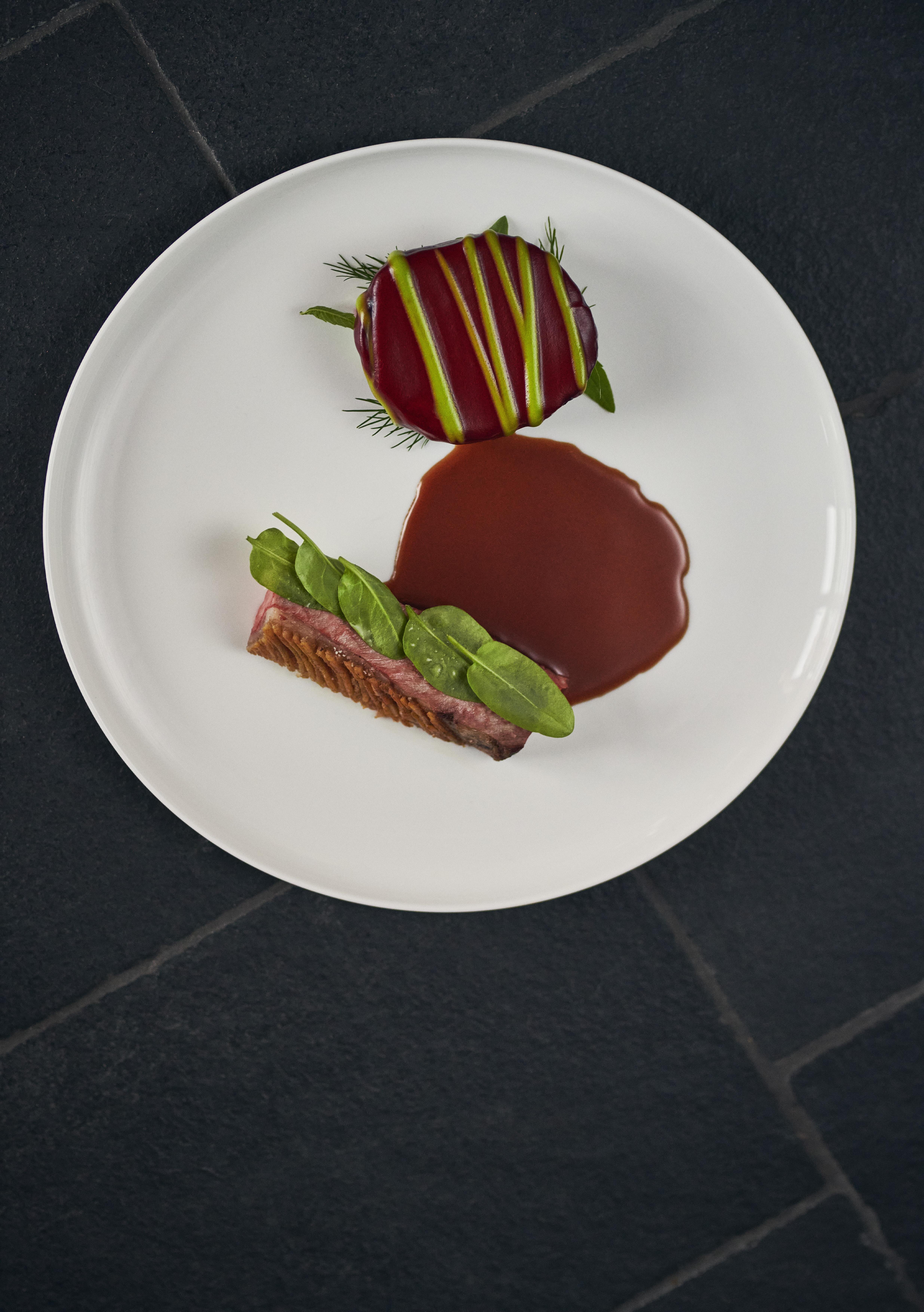
To The Moon And Back
Karim Iliya takes his underwater photography skills to space

Words: Iryna Zubenko Images: Art Bicnick & Karin Iliya

Iceland-based wildlife photographer Karim Iliya is nothing short of a nomad. One day he’s free diving with humpback whales in French Polynesia, the next he’s catching waves on a surfboard in Hawaii. But Karim’s next adventure is really out of this world. Together with eight other creatives and eccentric Japanese entrepreneur Yusaku Maezawa, Karim is getting ready for the first civilian lunar orbital mission scheduled to take place at the end of 2023.


I've always been fascinated by space. As a kid, I would try and learn about space and planets. In university, I took astronomy and relativity classes to learn about moons, our solar system, the Big Bang and how things formed. But of course, we take different routes in life. The route I took was photography and filmmaking.
And then at one point, a friend sent me a link to the dearMoon project. I
didn't think there was any chance of actually being accepted, but I applied and I did my best. Through a series of different interviews, videos and text, I found out that I was selected for the dearMoon crew.
Booking a seat to space
Approximately one million people applied for the trip. It’s crazy to think about the odds of actually being selected from among that group of people. The crew that’s going up will be the first group of artists to go into space. In the past, most of the people who've gone to space have been scientists, engineers and pilots. It'll be amazing to see what happens when you send a group of artists to space to try and create works that will inspire people back on Earth, providing us a new perspective of our own planet and
existence.
The mission is currently scheduled to last six days — three days to get to the Moon and three days back. We'll be launching from Earth, doing a loop around the Moon and coming back down to Earth.
The countdown to liftoff
I'm very excited to see what the training programme entails and what the preparation to go and basically live for a week in space will involve. Space is a crazy place to be. You're in an environment with microgravity where you're floating around, so you have to learn everything: how to eat, sleep and bathe — all of the things that we normally take for granted here on Earth. Lighting is different, the way that the light shines from the Sun and hits the Earth and bounces back — how will that play into photography and filmmaking? All of these are really interesting challenges that I look forward to navigating.
We are living on this amazing, perfect planet, which has everything that we need to survive — an atmosphere that protects us from the harmful radiation, cold and vast emptiness of space. And when you go up into a rocket ship, a lot can happen. I am confident in the team at SpaceX that the rocket will be incredibly advanced and able to keep us alive and healthy. For now, I'm not scared, but when I actually get up to the rocket and strap in, I'm sure that I will be a little bit nervous.
Cosmic shots
For me, it's not about going into space and looking toward the stars. It's actually about going up and looking back at Earth. I spend a lot of my time, effort and work trying to document wild animals and spaces in an effort to protect them. I hope when I'm up there, I can gain an overall perspective and use it to make images that will inspire us to do a better job back here on Earth.
When I tell people I'll be flying around the Moon in a rocket ship, it's hard for other people and me to process. I've been taking it in little bits and pieces when I look up at the Moon, see changes in the tides, or even when I'm watching fireworks being launched up into the air. I think of myself sitting at the front of a rocket and blasting off. It's kind of a wild concept to tell people that you're going up into space and leaving the planet. Not a lot of people have done it and I think most people are interested to know more. I've heard the Moon is made of cheese. So I will go up there and find out.
6 The Reykjavík Grapevine 3/23 Best before: April 13, 2023
Front
THE ISLANDERS
The urban spaceman himself
“It's kind of a wild concept to tell people that you're going up into space and leaving the planet.”
Two photographs from Karim's portfolio
How the fuck do Icelanders Swear?
As much as it’s discouraged by our elders, curse words tend to sneak into the vocabularies of most people at some point in their lives. Icelanders are no exception. However, given that Icelandic is one of the older languages still spoken, we were wondering: where do Icelandic swears come from? For an answer, we went to linguistics professor Þ órhallur Ey þ órsson at the University of Iceland.
“It seems that most of the swear words we use originated in Icelandic after the advent of Christianity,” Þórhallur explains. “Iceland was Christianized in the year 1000 CE, so most of the swear words are actually of Christian origin. That is to say, words like ‘djöfull’, meaning ‘devil’, (which ultimately comes from Greek), usually came into Icelandic via other languages. The
early ones via Old English, some via old Saxon (which is an old variety of northern German), and some via Danish.”
Outside influences are nothing new when it comes to the development of any language. With trade and moving settlements, vocabulary and cultural exchange is unavoidable. Though it does seem a little ironic that it was Christianity in particular that gave rise to the more popular naughty words.

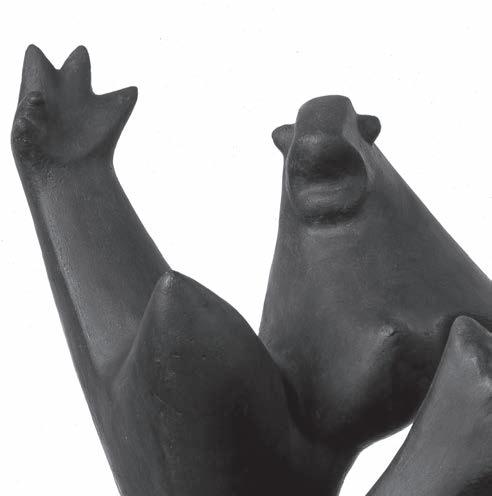
Þórhallur gives a few examples:

“‘Djöfull’ is an old one and as a swear word it’s quite common.
‘Andskotin’ is another one, a native word meaning ‘adversary’. Literally speaking, it’s someone who shoots against you (‘And’ – against;
‘skotin’ – comes from ‘skota’ – to shoot). The biggest adversary in Christianity being, of course, the devil. Another common curse of Christian origin is ‘helvítis’ or
‘helvíti’ which is the word for hell. The ‘hel’-part is actually pagan, referring to the goddess of the dead, Hel, but ‘víti’ is like an inferno. It’s the pit where damned people burn forever.

So, it combines pagan and Christian elements. For another example of this, the word ‘blót’ is of pagan origin and meant ‘sacrifice’ and got its connotation as a swear word after the introduction of Christianity. ‘Að blóta’ now means ‘to curse’ instead of ‘to sacrifice’.”
‘Djöfull’, ‘Andskotin’ and ‘helvítis’ tend to be the most common Icelandic swears but anyone walking around downtown Reykjavík is bound to overhear some Icelandicized English terms that are used to express frustration and emphasis.

“We’re getting some new swear words with English influence like ‘sjitt’ (shit),” Þórhallur says.
“‘Fucking’ is also quite common. With its own Icelandic spelling of course: ‘Fokking’. I think it became more famous here in Iceland during the financial crisis in 2008, when there were people protesting in front of the parliament and there was some guy holding a sign that said “Helvítis Fokking Fokk!!” (No translation needed, I guess).”
7 The Reykjavík Grapevine 3/23 Best before: April 13, 2023
Front We're actually fine. Really. It's nothing.
Words: Catherine Magnúsdóttir
ASK AN EXPERT Professor
03.02.–07.05.2023 Breath on a Window Sigga Björg Sigurðardóttir & Ásmundur Sveinsson Open daily 13h00–17h00 artmuseum.is #reykjavikartmuseum Ásmundarsafn Sigtúni 105 Reykjavík +354 411 6430 “One of Must-See Exhibitions in Scandinavia 2023” according to Vogue Magazine i8 Gallery Tryggvagata 16 101 Reykjavík info@i8.is +354 551 3666 www.i8.is 19.01.23–18.03.23 Kathy Butterly Eggert Pétursson
Image: Grapevine Graphics Dept. x Adobe Stock
Þórhallur Eyþórsson
What If Icelanders Had Colonised North America?
Exploring the possibility of a Vinland Colony and the various shapes it could have taken
Words: Valur Gunnarsson
Image: Grapevine Graphics Dept. x Midjourney
There is no arguing with the maxim attributed to Oscar Wilde that Icelanders are the smartest people in the world, in that they found America but had the good sense to lose it again. Smart or not, how exactly did Icelanders manage to misplace a whole continent? They and their cousins had already settled in distant lands with as inhospitable names as Iceland and on the even less hospitable but more attractively named Greenland. Why stop there? Did they find nothing worthwhile in North America?
Of course, there were disagreements with the Indigenous peoples that led to bloodshed, but the Vikings were used to that. Perhaps the simple answer is that the distances involved were too vast and there simply wasn’t enough motive to travel so far in search of land. But what if there had been something pushing people away from Iceland at the same time the new world was calling?
This was very nearly the case. At the same time Vikings were sailing west, Iceland was in the midst of changing religions. As it happened, Christianity was adopted peacefully in the year 1000, with the pagans simply converting on the understanding that they would still be allowed to worship their old gods in secret. This was very different from the Norwegian experience, where those who clung to the
old ways tended to be massacred.
What if the pagans in Iceland would have stuck to their guns (or swords, rather), or the Christians had been less inclined to compromise? Could that have catalysed an influx of religiously persecuted refugees into North America in the 11th century? And then what would happen?
Two scenarios come to mind.
The Long Siege
If we imagine thousands of pagans fleeing Iceland with nowhere to run, they might not have abandoned the palisades and gone back as easily as they did in our timeline. With plenty of timber in North America and good knowledge of ship building, they might have constructed a small navy and gone on the offensive. It’s probable that all of Newfoundland would have been conquered and then easily defended from canoe-sailing Indigenous populations. Perhaps this would have led to a new Viking age beginning in North America at the same time it was winding down in Europe.
Longships could have sailed up and down what is now the east coast of the United States and along the great rivers of Canada in search of plunder. But they would have found no cities to sack and not much worth stealing in the manner that Vikings were accustomed to. Even slaves would have been of little use without a market for their trade.
Would the Vikings have maintained a unified society? There is little reason to believe feuding wouldn’t be common here, just as it was in sparsely populated Iceland and Greenland — it was the reason Eric the Red left Iceland to found the Greenland Colony. Some might have broken off to found smaller colonies on the mainland, which may or may not have survived.
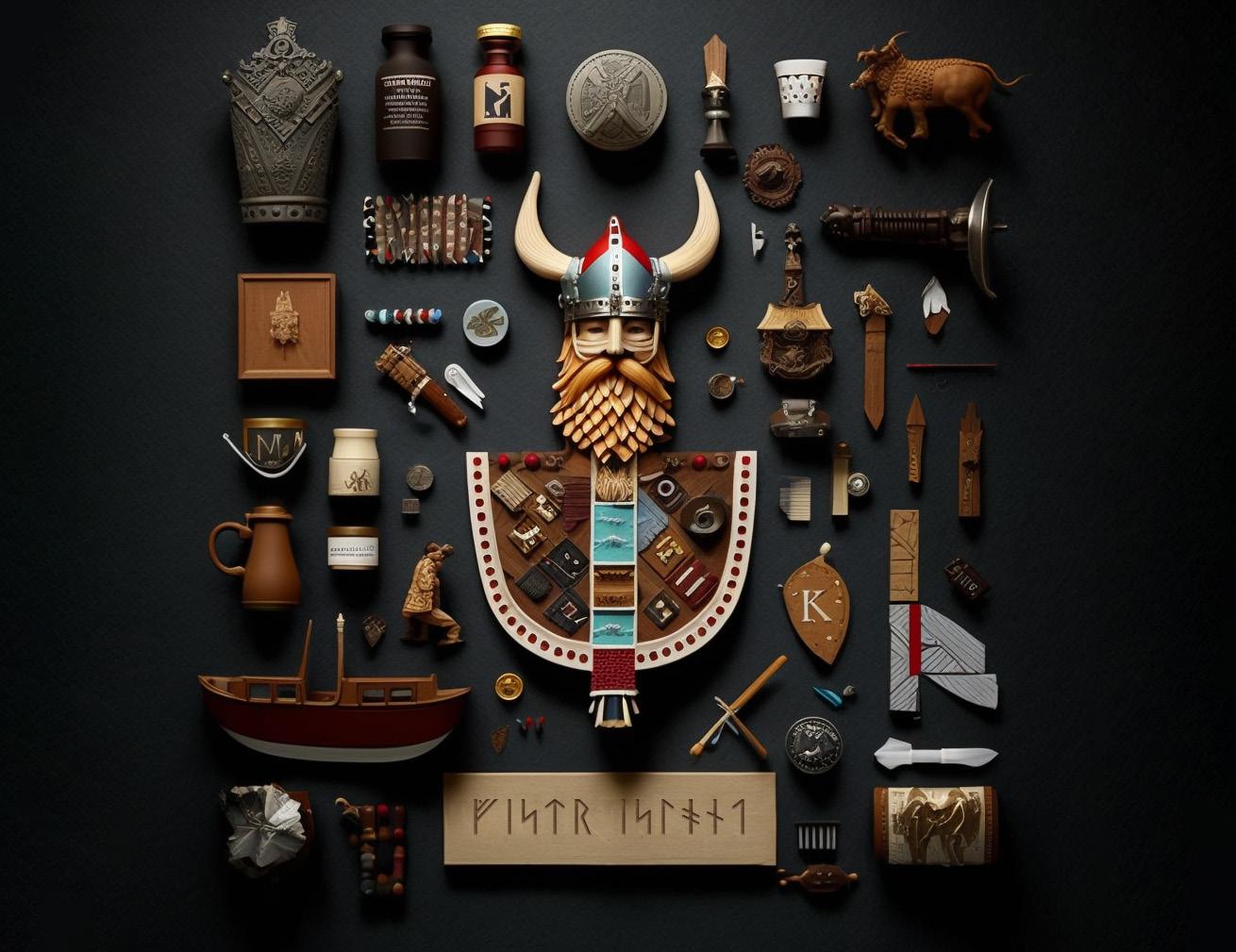
Perhaps Indigenous nations would have unified instead. In the 18th century, Hiawatha managed to create an alliance of five Iroquois nations that held off the British and French. An 11th century Hiawatha might have emerged against the common Norse enemy with even better results since the Iron Age Vikings had less sophisticated weapons than later European arrivals.
Still, the Norse would have their
work cut out for them. The first English and French colonies in North America in the 17th centuries floundered. In a winter famine of 1609-10, bodies were exhumed in Jamestown and eaten — in one case, a wife was murdered by her husband, who ate every part of her but the head. Only 60 out of 500 settlers survived the winter and what saved the colony was the introduction of a tobacco plantation in 1617.
Indigenous peoples sometimes came to the rescue, as is remembered every U.S. Thanksgiving, but this was unlikely to happen to the Vikings if they stuck to their violent ways.
Would the North American colonies have survived? They didn’t last in Greenland, despite hanging on for over 400 years. The Norse were geographically isolated in Greenland, but in North America they would have been politically isolated, too. There would have been little trade with the Christians who had driven them away from Iceland. Hard-pressed Greenlanders would have welcomed lumber and furs, but they had little to give in return.
Greenlandic walrus ivory was prized at the courts of Europe, but it would have been of little use to America-based Vikings.
It is possible that the last Viking settlement in Greenland was destroyed by a group of Inuit colonising the island in the 15th century. Something similar could have happened in America, with Viking colonies, weakened by harsh conditions, falling to an Indigenous advance. But North America is not Greenland — once established, the Vinland Colony’s chances of survival would have been infinitely greater due to more bountiful resources of the new world.
A Vinland Colony of any size might not have been completely lost to Europe, despite religious differences. North American Viking ships might have traded with, or even raided, Greenland and Iceland, despite the distances. The route the Vikings took from Newfoundland to the Greenland settlement is about 300 nautical miles along the coast and took six weeks, but the direct route is half that distance — a passage that could have been discovered in time. The American Vikings could also have been discovered by
later explorers driven by curiosity about whether the myth of pagans sailing to the end of the world was true.
The Danes sent an expedition to Greenland in the 18th century to find the remaining Norse Greenlanders and re-Christianize them. Something similar might have happened sooner with a Vinland Colony. Could a fleet from the Kalmar Union of the Nordic countries in the 15th century have set out to find the missing Icelanders? Or enterprising English sailors, already active around Iceland and even as far afield as Newfoundland at the same time, might have accidentally run into remains from a Norse settlement or even ships from a still existing one. Perhaps the colonisation of North America would have begun here by the united Scandinavians of the 1400s — the Swedes did colonise Delaware in the 17th century. Or perhaps the Viking descendants and the natives would have made common cause against the new interlopers? This brings us to another scenario.
Co-Operation
The second scenario is more likely to have worked in the Vikings’ favour. If they could have learnt to get along with the far more numerous Indigenous peoples of North America, it could have been beneficial to both sides. It was, in fact, not uncommon for the Vikings to adapt to their surroundings. In Slav countries, they became Slavicized. In Normandy, they became French. Why wouldn’t they adopt the cultures and habits of North America’s First Nations?
In other parts of Europe, the Norse first became a ruling class before they adapted the customs of their subjects. This was unlikely to happen in North America as they were far too few in number for conquest. Any exchange would have to have been on a more equal basis. For Christians, sure of the superiority of their religion, that was unthinkable.
Relations with the Inuit in Greenland seem to have been uniformly hostile. In fact, one of the reasons the Norse died out was their clinging to European customs rather than adapting to the changing climate as the Inuit did.
But in the case of the hypothetical Vinland Colony, we have pagans with fewer qualms about adhering to different ways of life. They might have even found similarities between their own pantheon of nature gods and those revered by Indigenous tribes. Had the Norse managed friendly relations, they could have prospered in the New World, likely eventually becoming absorbed by the local cultures. This is in fact what some people believe did happen to the Norse in Greenland, that they joined up with local tribes and became one with them, even moving over to Canada — although research in both Greenland and Canada has turned up little that could substantiate this and Norse graves found in Greenland show no evidence of Inuit DNA.
In this scenario, perhaps palefaces would have been found among First Nations as the European powers started conquering the continent in the 17th century, telling stories of ancestors coming from across the sea. This would no doubt have been the source of much puzzlement, until someone would finally have connected them with the pagans who left Iceland over 600 years earlier.
Would it have led to less disregard for the lives of Indigenous peoples if it were clear that some were originally of European descent? Perhaps not, but intermingling with the Indigenous would certainly have allowed the Vikings to survive longer in North America than they in fact did.
8 The Reykjavík Grapevine 3/23 Best before: April 13, 2023 Front
Starter kit for your new life in Höfn-í-Manhattanfirði
The Útlendingur’s Guide To Getting Shit Done
Just get your fucking Icelandic drivers licence already

Before any of my fellow immigrants feel judged, I’ll offer that this column is as much meant to be informative for those not sure how to navigate various aspects of Icelandic bureaucracy as it is dressing down of myself for being really fucking lazy when it comes to ticking items off my institutional to-do list.

The first task to conquer? Trading in a foreign drivers licence for an Icelandic one. I know, I know, “but Catharine,” you’re saying. “That’s a really quick process.” Then why did it take me 13 years to do, huh?


Exchanging a foreign licence for an Icelandic drivers licence is a quick and painless process for those with licences issued in the EEA, U.K. and Japan. After six months of residency in Iceland, those lucky individuals simply have to visit island.is/erlendoekurettindi and fill out the form available to download at the top of the page. Bring that completed form, a passport photo, your foreign-issues licence and a cool
8.600 ISK to the Syslumenn office and you’re in business.



Those of us who obtained a drivers licence outside the EEA, U.K. or Japan have to jump through a few more hoops before cruising Route 1. We have to do everything mentioned in that last paragraph — the form, photo and fee — plus take the written and practical tests.
It’s these extra steps that activated my own procrastination, but here’s what to do:
Buy the relevant test book from Frumherji. I bought a book titled “Driving in Iceland, Category B” by Guðni Karlsson and Gunnsteinn R. Sigfússon, but if you’re super cool and drive a motorcycle or heavy machinery then you’ll need the book outlining the regulations of your specific driving class.
Read the book, take notes, study and take the practice tests that are also available for purchase from Frumherji — there’s a lot to know. You can also take practice tests on an app called “Bílprófið.”
Once you’re confident in your knowledge, book a time for the
written exam with Frumherji and go pass it.
With the written exam in the rear view, it’s time to conquer the practical test. Find a driving instructor through sites like Netökuskólinn.is or Aka.is and explain your situation to them. If you’re an experienced driver, they’ll likely book your practical exam and run you through a single lesson immediately beforehand. If you’re less confident, you can book multiple sessions to prepare more thoroughly for the practical exam.
For the practical exam itself, you’ll use the instructor’s vehicle to chauffeur the Fumherji examiner, heeding their instructions to turn, pull over or park. Assuming that all goes to plan, they’ll hand you a signed and stamped paper you can use immediately as a temporary licence. You’ll receive your digital licence to your phone within a business day or two, and your official plastic licence will be available from Syslumenn after three weeks. Drive safe.
9 The Reykjavík Grapevine 3/23 Best before: April 13, 2023 Front
Forlagið
39 | www.forlagid.is ICELAND’S LARGEST
THIS IS ICELAND
Words: Catharine Fulton Image: Adobe Stock + GGD
bookstore | Fiskislóð
BOOKSTORE
Memories from Iceland that ft into your pocket! You could be this happy
NERDS OF ICELAND, UNITE!
The ever-growing
– and other tabletop

role-playing games –

You are entering a dimly lit room. Around you, figurines of humanoid and monstrous creatures occupy every available surface. You find a table littered with papers, but upon trying to read them you see the pages are covered in boxes filled with numbers and strange, seemingly unconnected terms. A code perhaps? Upon further investigation you spot a selection of colourful gemstones, each side embossed with numbers. Wait, not gemstones. Dice. Suddenly a figure appears at the head of the table behind a small propped up screen. It’s a Dungeon Master. Roll for initiative.
The tabletop role-playing game (TRPG) Dungeons & Dragons has been a staple of nerd culture since its advent in the 1970s, when creators Dave Arneson and Gary Gygax set out to combine their love for miniature wargaming and the fantasy genre — you know, so they could fight trolls instead of Nazis.
Often considered to be the height of nerdom, D&D quickly garnered a reputation as a catalyst for social suicide, played only by the most hardcore of outsiders who do math for fun. That, plus it scared the bejesus out of parents who thought their kids were getting into satanic cults, with rule books depicting witchcraft and devils. So, while popular for its gaming innovations and creative potential with players, Dungeons & Dragons was long
kept on the downlow.
That is until the perfect storm of a new rulebook edition, a general rise in popularity of all things dweeb and increased internet exposure began to brew in recent years. What was once limited to household name status within circles of gamers and fantasy fans, D&D has steadily dungeoncrawled its way into the mainstream.
How the hell do you even play Dungeons & Dragons?
Looking at the starter pack of three tomes — the Dungeon Master’s Guide, the Player’s Handbook and the Monster Manual — is intimidating. They have
a lot more heft than the standard brochure that comes inside a board game box.
But to boil it down: The Dungeon/ Game Master creates a world and a story. The players create their characters. Those can be all kinds of fantasy races, anything from elves and dwarves to anthropomorphic animals. The characters also have a class — ranger, druid, warlock, or barbarian, to name a few — that gives them specific abilities. Vicariously through their characters, players go on adventures and end up telling a story in their DM’s world.
They fight monsters with their abilities or go on other missions where they have to roll dice to see if they succeed in their endeavours. If they roll high enough, they can pick a lock, increase their powers of persuasion or hit an enemy and then roll more dice to see how much damage they inflict. It all comes together into a magnificent table-bound improv theatre group or sorts.
Are you with me so far?
If a story goes on for multiple sessions (typically lasting three to four hours per session) it can be considered a campaign. One session of a selfcontained story is called a One Shot. Apart from the officially published material of settings, gadgets and rules, players are also free to “homebrew” concepts for their games, creating something completely new with the power of their imagination. Pretty wild, right?
From Niche to Network
Iceland has always had its own community of nerds. High Fantasy is nothing new in the land of the Edda. It is unsurprising, then, that over the years
Dungeons & Dragons has carved out its own corner in Reykjavík alongside comic books, video games and Sci-Fi movies.
Helgi Már Friðgeirsson has been active in the TRPG scene for 30 years, going from playing privately with his friends to chairing the first local guild of nerds and role-players to offering his services as a professional DM to those who want to try their hand at the game.
“It was maybe 10 years ago that I floated the idea of running games for money and at that time I was almost shouted down by a faction of the community,” he recalls, explaining that the general attitude had been that TRPGs should be exclusively played with friends for free, because that’s how it had always been. “But what if you don’t have those friends that want to play or have the experience? It’s daunting when you’re not already in the hobby to look at the three books thinking ‘Oh I have to read all that before I start?’” Hence the idea to go pro as Dungeon/Game Master.
Playing Field
People playing Dungeons & Dragons professionally for an audience on sites like YouTube or Twitch is not a new concept anymore. Their efforts have gone a long way toward increasing exposure of the game and, as a result, the demand for it. Especially when you go through two years of lockdowns, desperate for long-running entertainment, things to do and ways to keep in touch with other humans.
There are several sites enabling players to meet online and role-play live, like Roll20, StartPlaying, Fantasy Grounds, and Quest Portal. They allow players to maintain an overview of their character stats and look at maps of the

10 The Reykjavík Grapevine 3/23 Best before: April 13, 2023
“It was maybe 10 years ago that I floated the idea of running games for money”
—
“I was almost shouted down by a faction of the community”
cult of DUNGEONS & DRAGONS
––
virtual game area.
And that’s not even going into the social media corner D&D has carved out for itself, where millions of people share anecdotes of their fantasy adventures as well as original characters or self-made dice, sets and minis online. It has even spawned a treasure trove of memes about all the queer potential of Tieflings and those slutty, slutty bards. Fans being allowed out of their dungeons and towers again as the pandemic abated has naturally led to them going on quests to experience the fantasy in real life, and to Game Masters expanding their circles and organising events.
Gísli Gunnar Didriksen Guðmundsson, aka DMDidriksen, is one of those pro GMs in the scene, having started promoting his skills online a few years ago.
“The process wasn’t complicated,” he explains. “I got a friend of mine to take really nice pictures and then I made a Facebook page and I was off. I did a few trial runs with groups of friends who I knew hadn’t played before and acquaintances I didn’t know, just to try my hand at running the game for absolute beginners. It went really well, so I put it out there and it’s just been growing ever since.”
He has since hosted events, for example at Spilavinir (Spunaspilavinir which takes place once a month) or D&D nights at the bar Gaukurinn, where people can book a seat at one of the game tables and try out the game in a One Shot. No preparation is required of the player’s side; materials and even characters for the night are all provided.
Enter: Players
Inga Morrison also became one of the
local GMs offering their expertise after being asked by Gísli to join in. “One day he just messaged and asked if I wanted to hop in and join — mostly, I think, to be a token female DM to shake it up a little bit,” she recalls with laughter. “Typically, it’s just guys DM-ing, but there’s no lack of girls in the scene.” In fact, the pool of players has become more diverse over the years, which in turn has shaped the gameplay. The game certainly has come a long way from some of its more *ahem* questionable depictions of women and other races in the 70s — though there’s always room for improvement.
Dungeon Master Þorsteinn Már Gunnlaugsson started out playing as a teenager and has since expanded his circle of D&D players over the last 20 or so years. He’s incorporated tabletop role-playing games in his work as a teacher and has published material for the fifth edition of D&D as well as for Scandinavian TRPG systems (Trudvang; Ruin Masters). He too sees a lot of merit in more diverse player groups, with varying levels of playing experience or people coming from different backgrounds.
“When the group is more diverse, when you have, for instance, nonbinary players or female players you get different solutions,” he explains. “For us older Game Masters, that’s probably been a bit of a challenge. We also like to think that the problems we pose should be solved in the more violent and direct manner, typically, whereas when we have more diverse groups you have to pose problems that can be solved in different ways because the approach will be different.”

Þorsteinn says he continuously wants to broaden his horizon as a Game Master and that the fifth edition of the game, with its sleeker and more
easily comprehensible design, has made that a lot easier. The biggest downside is that, with more players wanting to try the game, there’a a need for more Dungeon Masters to lead adventures. That’s been a bit harder to come by.
Masters of the Universe
As entertaining as TRPG streams and pre-recorded shows can be, they can be a bit intimidating to newcomers. Seeing Game Masters with professional acting backgrounds step onto a prepared set and play with other experienced entertainers is often as inspiring as it is terrifying to people wanting to do the same for their friends (or strangers at a game store). As Helgi put it, “I had the opportunity to suck as a DM and then get better by failing. That’s how we learn. Also, my players had nowhere else to go.”
With the ultimate goal of the game — at least most of the time — being to have fun and try out different roles, Helgi emphasises the potential of roleplaying games to encouraging empathy and social skills. “Roleplaying can also be used to explore stories and feelings and situations where you get prepared for situations that are harder in real life” he says. “Being together, playing together. Getting to put on other hats. Getting to be other people. That’s at least the main draw for me. It doesn’t hurt when I get to criticise somebody to their face, but ultimately it’s empathy through learning.”
Inga also underscores the social and creative potential of the game, from both the creative aspect of painting minis or building props, to imagining characters and even an entire world.
“You get to lead your friends into a wild
ride and that’s the biggest appeal of DM-ing for me,” she says. “You also get to know all the secrets. I think that’s also what helps people to keep going.”
Being a Dungeon/Game Master takes a lot of effort and organising a group of people together that have lives and responsibilities is no easy feat. Ultimately, though, the potential for a bottomless creative outlet keeps the DMs in the game.
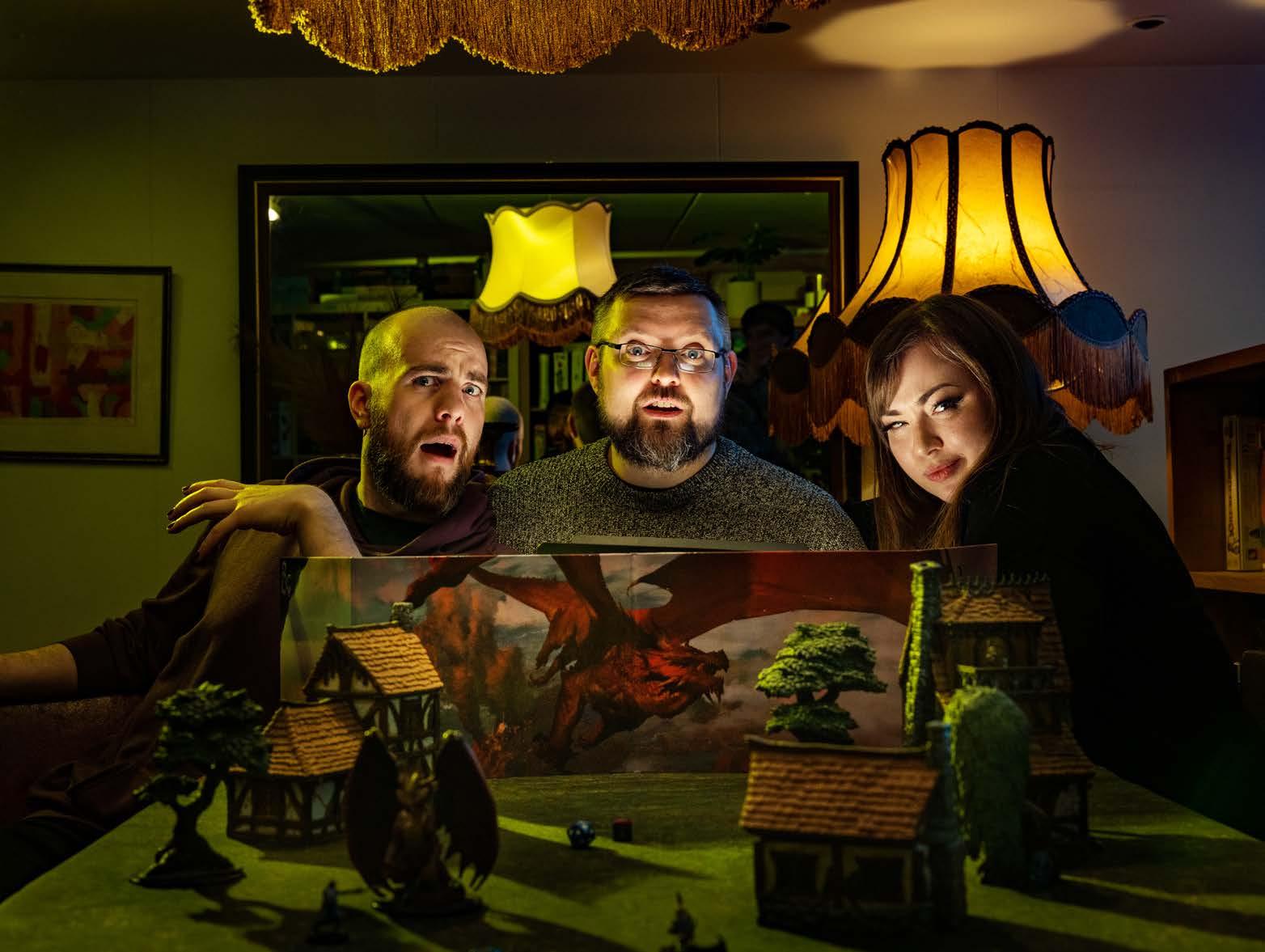

Once you’ve gotten a taste of the creative freedom role-playing games can provide, there’s a risk of uncovering an unquenchable thirst for creating universes, settings, characters and combat scenarios. We haven’t even touched on all the different genres outside of fantasy that TRPGs can take place in.
Looking for some Lovecraftian horror? Done. Science Fiction? There. Mad Max style racing concepts? If you can think it, you can make it. Warning: Game Mastering may come with a god complex. Player discretion advised.
The Wizard in the Room
The role-playing scene here in Reykjavík is still pretty proportional to the population, at least in real life. The Facebook group Roleplayers á Íslandi boasts nearly 2,700 members and there is an established rotating cast of GMs these days for events like Spunaspilavinir or Gaukurinn’s D&D nights.
There are ideas floating around among some of the role-players and GMs specifically to form a more structured group, for example via the roleplaying organisation Hlutkesti. The last attempts at getting people together were unsuccessful, though, and concepts like paid memberships for booking rooms to run specific games
11 The Reykjavík Grapevine 3/23 Best before: April 13, 2023
or get a seat as a player regularly are a bit up in the air right now.
And then there’s the wizard in the room.
For the uninitiated, the rights to the game system Dungeons & Dragons are owned by a company called Wizards of the Coast, which releases all the official published material around the game (such as the different rule book editions). Since 2000, the game has been published under an Open Game License (OGL), meaning that third parties are allowed to create written products (adventure modules, monsters, rules etc.) using the D&D system for sharing.
This has enabled countless creations within and around the scene, with many people even building their livelihoods around them. Earlier this year, however, Wizards of the Coast came under heavy fire after a draft revision of the OGL was leaked. This
How do you want to do this?
revision would have invalidated the original model, claimed the right to all content released under the OGL — seemingly making a grab for a bunch of intellectual property to use as their own — and demanded notification about any income surrounding the material as well as royalty fees upon reaching a certain income level.
This was widely panned as a bad move. In short, the community made itself heard, signed open letters and cancelled subscriptions. Even industry figures spoke out against the revisions and questions arose about the legality of the potential deauthorization of the OGL. Until Wizards of the Coast seemingly succumbed to all these critical hits and announced that it would not only leave the OGL in place but take steps to irrevocably make the D&D core rules openly accessible under the Creative Commons.
We love to see a dark tower fall. Or at least get taken down a peg.
Despite the community’s success in keeping the game openly accessible to everyone, trust in the wizard company has definitely been shaken. Even locally there are aftershocks, but most people see this as an opportunity to move beyond the big brand name that is Dungeons & Dragons to try out other systems. This also goes for Spunaspilavinir.

“I think we’re going to do about 50/50 going forward,” Helgi says. “Have maybe two or three D&D tables and then two non-D&D tables. Roleplaying shouldn’t be a monolith with just D&D and nothing else. It really depends on what you want to do in terms of what the best game system is, because like movies, role-playing has genres. I run a lot of horror genres, more personally than professionally, but horror games are probably the next big thing below traditional D&D.”Playing tabletop role-playing games
is still a pretty niche hobby. But it is not as niche as it used to be. It’s less secretive now, people talk more openly about their gaming experiences — or at least their piqued interest — and it seems to fill a specific need for social activity. Gísli also points out how the shared experience can be super gratifying even if no actual dragons are slain during a session. “I want to encourage anyone to try it, at home or with a hired professional, because it’s such a rewarding experience. You make a world together and effect that world, see the consequences of your actions, it’s such an insane thing. You experience something at the table that is not real, but your internal experience, the emotion is, your memories of it are real.”
Luckily, the public panic around D&D and Satanism has diminished since the 80s. And while the original system can still be seen as the flagship of TRPGs, the sky's the limit when it comes to creation.
Just be careful not to become addicted to collecting dice.
It’s a whole thing.

12 The Reykjavík Grapevine 3/23 Best before: April 13, 2023
Helgi
Gísli
Inga
“One day he just messaged and asked if I wanted to hop in and join — mostly, I think, to be a token female DM to shake it up a little bit.”
Culture
Aldrei fór ég su ð ur
April 7 - 8 — Suðurgata 11, Ísafjörður — Free
Is there really anything worth doing around Easter except eating chocolate easter eggs? Maybe you’d like to eat chocolate eggs in Ísafjörður while attending a music festival? A longtime refuge for city dwellers to escape Reykjavík during Easter, Aldrei fór ég suður is a celebration of the best acts in Icelandic music. There is no need to pay for tickets, as entrance has always been free. You’ll only need to organise how to get there. Don’t forget to bring your trusty lopapeysa and a good pair of dancecapable boots. JB
Stockfish Film Festival
March 23 - April 2 at multiple times — Bíó Paradís
— Ticket Price TBA
Head on down to Bíó Paradís for the ninth annual Stockfish Film Festival. A platform to strengthen collaboration between international and Icelandic filmmakers, Stockfish presents 20 titles. with select award-winning films as well as special screenings. Additionally, the festival will also feature its short-film competition, Shortfish, promoting the most promising new filmmakers. If you want to submit your own short-film don’t dawdle, the submission deadline is March 4. JB
The Renaissance of Milk Cartons
Emilia Telese exhibits etchings created from trash
Words: Catharine Fulton Images: Art Bicnick
Ferna opens at Íslensk Grafík (Tryggvagata 17)
March 4, 17:00, runs through March 18.
How did I get to the bombshelter?
Runs until May 14 — The Nordic House — Free


When is a war over? How does one find peace when your country is in unrest? Those are among the questions seven contemporary Ukrainian artists explore at the Nordic House. In a multidisciplinary group exhibition curated by Yuliia Sapiga, the artists reflect on the invasion of Ukraine, the wish for a peaceful life, the paths to survival, and the future ahead. An exhibition you cannot miss. JB
Artist talk & live performance: 17:00, March 18.
The happy tones of Italian children’s music fill the cavernous workspace of Íslensk Grafík. The peppy pop feels at odds with the imposing machinery in the space, some of which dates back to Victorian times, but complements the happy sounds of children enjoying an impromptu playdate while their parents work through their school’s winter break.

Emilia Telese walks me through the space, her white work coat smeared and smudged with black ink as her gloved hands work diligently to remove excess pigment from an etched image of two women sitting at a balcony door. “You can’t see it, but beyond the balcony is Mount Vesuvius,” Emilia tells me of the etching she created from a photograph of her grandmother and aunt engaged in conversation at home in her native Italy.
While there’s a personal story in the subject matter of the image in her hands, the materials the artist is working with are just as interesting.

Etchings for print making would traditionally be carved into metal plates, but Emilia is currently polishing ink off an unfolded carton that once contained oat milk. They take centre stage at Ferna, Emilia’s upcoming exhibition at Íslensk Grafík.
“One of the things I’ve been doing recently is working on milk packaging, so the cartons that we use everyday for milk — and in particular the ones that are made of many layers of different materials,” she explains.
“There are many types of milk cartons or beverage cartons. Some of them are made just of paper and they are more recyclable. But some of them are made of different layers like plastic, metals like aluminium, and paper. Those ones are much more difficult to recycle.”
The majority of these less-recyclable cartons are manufactured by Tetra Pak in Sweden. While Tetra Pak has taken steps in a number of countries to build recycling facilities that are capable
of separating their cartons’ paper, plastic and metal layers, the facilities aren’t numerous enough to handle the volume of cartons in circulation. Iceland, for example, sends such packaging to Sweden for processing or simply buries it in a landfill.
“Statistically — and this is something Tetra Pak has recognized — only 20% of these multi-layer cartons are recycled,” Emilia laments. “The rest of them go to landfill.”
Past in bubble wrap
One of the themes running through Emilia’s 25-year career as a professional artist is a focus on social and political problems. She tells me about a particular project she created in 1995 for which she created a fashion line out of bubble wrap, complete with adhesive sections on which to store your trash while out and about rather than littering.
For Ferna, Emilia has created prints from 10 etchings, ranging in size from a single unfolded carton to larger works carved on several cartons adhered together. They’ll be displayed alongside three works Emilia created in collaboration with renowned Italian artist Edoardo Malagigi, whose works regularly employ the materials we tend to regard as disposable.

“Quite a lot of things we do in life have an impact on the Earth, and packaging is one of them. So I’ve decided to make art out of something that is seemingly throw-away, but in reality lasts many decades in the environment,” Emilia explains as the sounds of happy children at play erupt in impossibly loud echoes from the adjoining exhibition hall. “I’ve decided to make traditional etchings out of milk cartons.
I use Renaissance techniques to carve and etch into these cartons and then I print them with a technique first used by Albrecht Dürer in the 15th century.”
While the technique is traditional and the paper being printed on is handmade in Italy, it doesn’t mask the unconventional materials in use. Pointing out how the ink highlights the creases and folds of the flattened cartons, Emilia explains that she’s not trying to make them into something other than what they are.
“I am leaving them as milk cartons and playing with the shapes that the cartons have themselves. This also gives them a quality that I’m interested in.”
13 The Reykjavík Grapevine 3/23 Best before: April 13, 2023
CULTURE NEWS
Stay like a local
8 hotels, restaurants & spas in the heart of Reykjavik


These developments are relatively recent, Hjálmar explains. In 2014, a fire broke out and engulfed a building in the middle of Skeifan. “With the fire, there was a newfound interest. Architects surveying the area established that Skeifan could accommodate up to 750 new apartments,” Hjálmar says. Although that sounds like a radical transformation, Hjálmar assures me this will be done steadily. “There is no intent to drive out current businesses. I am convinced that there is room for both auto shops and residents. It will be a mixed-use zone after all,” he says. Since its inception, Skeifan has been a pit of despair. Why are we seeing change now? Hjálmar replies: “The financial crisis in 2008 opened up some breathing room to do things di erently. Because of the recession, there wasn’t much activity taking place: construction halted and architecture firms had nothing to do. From that anti-space, the Master Zoning Plan of 2010-2040 was made. People had big ideas, emphasising a more people-centred environment with increased density and the elimination of sprawl, better use of land, and decreasing car dependency.”


It’s certain to say that Skeifan’s industrial days will soon be over. Whether space will remain for that wiener-gurgling raven remains to


Culture
[
]





KONTOR REYKJAVÍK
OUR STORES IN REYKJAVÍK: FARMERS & FRIENDS
The Fucking Genius of Reykjavík Ensemble
Ewa Marcinek and Pálína Jónsdóttir are a dream team. A playwright powerhouse. The future of Icelandic theatre.
Since establishing the Reykjavík Ensemble International Theatre Company in 2019, the creative duo has mounted performances that break the mould of Icelandic theatre, been named Reykjavik’s Art Group of 2020, and were nominated as the Pioneering Newcomer of the Year at the 2020 Icelandic Performing Arts Awards. In January, it was announced the groundbreaking company has been awarded a three-year contract with the City of Reykjavík, providing them an infusion of 2 million ISK annually to
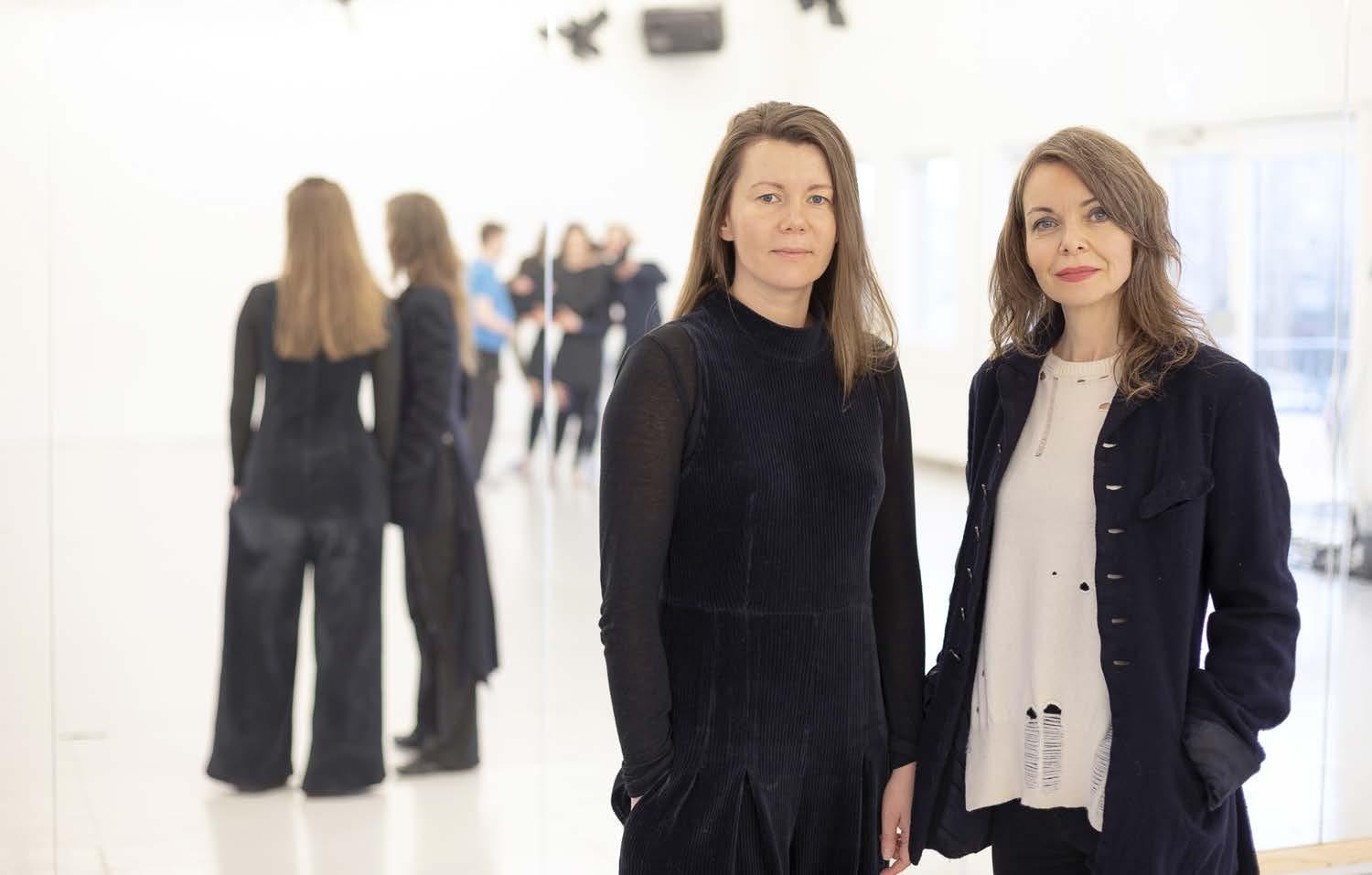
support their inclusive multinational, multicultural and multilingual art.
The Reykjavík Grapevine sat down with Ewa and Pálína during a break from rehearsing Djöfulsins snillingur (Fucking Genius), ahead of its March 30 premiere at Tjarnarbíó.
Reflecting Experiences
“It’s a piece that actually reflects the immigrant experience of coming to this country and what it takes also to be an artist immigrant in this country,” Pálína explains of the production — the company’s fourth in as many years.
“There are a lot of obstacles that the protagonist has to face and deal with
during her journey to realise the goal of her decision to come to this particular country — the promised land of sorts.”
It’s unsurprising to learn that Pálína, the company’s artistic director, spent 14 years in the New York theatre scene. She speaks fast and passionately about Reykjavík Ensemble, the immigrant artist experience and the importance of increased diversity in the country’s theatre scene.
The juxtaposition to this is writer and producer Ewa’s calm quiet, as she adds that Djöfulsins snillingur “is a dark comedy because sometimes laughter is the best commentary on what happens to us. So we talk about immigration, we talk about integration, and some about linguistics — the situation of being in a new country.”
Ewa and Pálína are careful not to divulge any secrets — The Grapevine, like the rest of the public, will have to make it out to Tjarnarbíó if it wants to get the full picture of Djöfulsins snillingur — but they explain that the production is about the protagonist Uriela who aspires to audition for the National Circus but falls into a cycle of applications, authentication processes and bureaucracy. Her eagerness to
integrate into the Icelandic cultural scene is contrasted by the experience of another character, a perpetual immigrant, who has been in Iceland for hundreds of years. A grocery store self check-out machine also comes into play, but inquiring about that is where the synopsis ends, lest we’d have to slap a “spoiler alert” on this article.
High Hopes & High Standards
Longtime readers of the Grapevine are familiar with Ewa for her book Ísland Pólerað (which could be translated as Polish-ing Iceland) — the source material of the stage production Reykjavík Ensemble mounted in March 2020.
“It was not published yet but I asked her to share it with me,” Pálína explains. “And I said, ‘Ewa, I think I can make an adaptation of your piece.’”
“And that was the COVID piece that opened and closed on the same evening,” she continues. “We had to wait for the next window of opportunity to remount it, but it only played four times in this country. So it was a total depressive shock not to be
16 The Reykjavík Grapevine 3/23 Best before: April 13, 2023
Words: Catharine Fulton Images: Art Bicnick
CULTURE FEATURE Culture
Promoting multiculturalism and integration in Icelandic theatre.
Co ee & Sandwiches Hafnarstræti 11 ka _o_le
The most special co ee from specialists in speciality co ee.
able to play it and we lost a lot of money.”
But, despite the pandemic dealing a particularly hard blow to artists and arts organisations like Reykjavík Ensemble — a point about which Pálína admits she holds a grudge, saying “I’m very saddened that it affected us really
Iceland and demanding they jump through hoops to prove they are, in fact, artists.
“Because they’re not educated in Listahaskoli Island or something,” she laughs.
This all comes back to the themes at the centre of Djöfulsins snillingur. “Urelia is dealing with
to support them, to lift them. And that’s what we do in our company.”
But not all countries are created equal, from the immigrant perspective. “Iceland is very specific,” Ewa clarifies “It’s all about having connections, and even those who are native here, but if they travel abroad to study
The Movement Has Begun
—and we're all in
What: Hreyfing er hafin
When: March 10 @ 20:00
badly, and our artists and our company” — they ploughed on.
“From the beginning it was very important for us to produce really original shows of great artistic value,” Ewa says. “Professional shows. Professional actors and artists working on the production, but at the same time being as open as possible to our community, to all the newcomers.”
“We were able to get so much support from both Reykjavikurborg and the government through the performing arts fund, so it looks like it works what we’re doing.”
Ewa addresses a common elephant in the room when discussing “immigrant” art projects, lamenting that they often skew toward folksy and place emphasis on “just getting together” above professionalism. “But we really want them to be on a professional level, to show the real talents that are coming here.”
“We didn’t have anything in the theatre world of this country of this nature where we welcome talent from wherever they may come from, whatever languages they may be operating, a chance to be included in this community.”
Integration Possible
The theme of integration and inclusion that recurs in many of Reykjavík Ensemble’s productions is also a mission of the company as a business, with Pálína explaining she is determined to change the culture of excluding artists who perhaps weren’t educated in
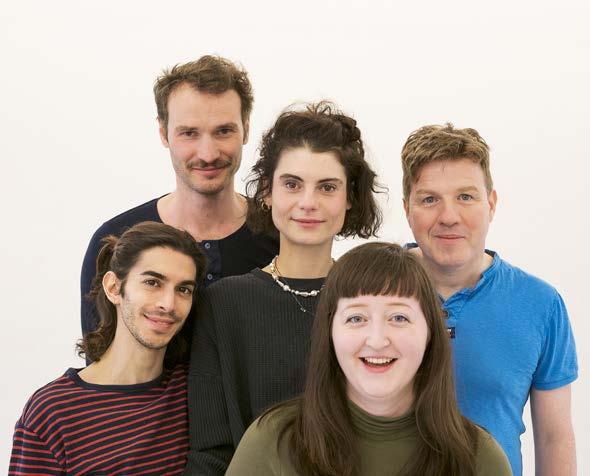

this new country that has its own system and we learn throughout the play that the system may not be flawless. So the play operates a lot on these black comedy, Kafkaesque situations that are challenging and absurd in their nature,” Pálína explains. “And for the artist to hold on to her mission that she knows she is an artist and that’s what she’s meant to do and that’s how she wants to contribute to this amazing country, she needs to be seen and she needs to be given a chance.”
“And that’s very much in line with what immigrants experience in new countries. They may be totally invisible. And it’s impossible for anybody — for any human being I know — to do things entirely by themselves. They need somebody
and then they come back they may have a problem joining the market. So imagine how hard it is for those who are from abroad and are educated abroad to join. That is also what we’re playing with in Djöfulsins snillingur.”
“It is the promised land,” Ewa concludes, “but we need to help those who arrive here or who have been here for some time but don’t know how to fulfil their dreams. Our play is about following your dream and working toward it against all the obstacles.”
Djöfulsins snillingur premieres at Tjarnarbíó on March 30, with performances also scheduled for April 13 and 23. Tickets are going fast, so secure yours ASAP from Tix.is
Where: Kex Hostel

Cost: Pay what you can
Longtime Grapevine friends and grassroots art organisers post-dreifing continue their monthly concert series Hreyfing er hafin (movement has begun).
Having previously been organised monthly at Húrra, post-dreifing is jumping over to Kex Hostel to throw a party in the Gym and Tonic hall.

With a focus on showcasing artistic talent, the concert series aims to promote independent and exciting new acts. The show’s roster is a long one, so no matter what time you show up — because, yes, you will be there — there’s someone bound to be rocking it onstage.
The confirmed lineup includes the bands Supersport!, Trailer Todd, Sameheads, Einakróna and Ókindarhjarta, with the sixth act to be confirmed. It’s a mix of both seasoned performers and other bands that are relatively new to the scene, with genres varying from indie-pop to math-rock, which undoubtedly gives off a certain C86 feel. The entrance fee will be posted as a recommended price, but people in need of that moola are encouraged to pay what they want, or offer some other type of imbursement (maybe go fetch some spare cables when the other ones get ruined).
Oh, and this is the first gig in a long while that the Reykjavík Grapevine is collaborating on. Watch this space for more Grapevine-curated happenings in the weeks and months to come.
For those who have been lost to the world for quite some time, post-dreifing is a DIY-based art collective operating within the capital area. Its main mission is to create platforms for underrepresented artists working in and around the Reykjavík area. It was founded by young, independent artists who felt the need to support each other through a loosely-knit collection of individuals, continually in motion and perpetually creative. JB
17 The Reykjavík Grapevine 3/23 Best before: April 13, 2023 Best Newcomer* Book a table on brut.is Best Seafood* Best Brunch* Pósthússtræti 2 Brút - B út - Brút - Brút - Brút - Brút - Brút - Brút - Brút - B út - Brút - Brút - Brút - Brút - Brút - BrútBrút - Brút - Brút - Brút - Brút - Brút - BrútBrút - B út - Brút - BrútBrút - Brút - B út - Brút - B út - B út - Brút - Brút - BrútBrút - Brút - Brút - Brút - Brút - Brút - Brút - B út - B út - Brút - Brút - Brút - Brút - Brút - Brút - Brút - Brút - Brút - Brút - Brút - Brút - Brút - Brút - Brút - Brút - Brút - Brút - Brút - Brút - Brút - Brút - Brút - Brút - Brút - Brút Brút - B út - Brút - Brút - Brút - Brút - Brút - Brút - Brút - Brút - Brút - B út - Brút - Brút - Brút - Brút - Brút - Brút - Brút - Brút - Brút - Brút - Brút - Brút - Brút - Brút - B út - Brút - Brút - Brút - Brút - Brút - B út - Brút - BrútBrút - Brút - Brút - Brút - Brút - Brút - Brút - Brút - Brút - Brút - B út - Brút - B út - Brút - Brút - Brút - Brút - Brút - Brút - Brút - Brút - Brút - Brút - Brút - Brút - Brút - Brút - B út - B út - Brút - Brút - Brút - Brút - Brút - Brút - Brút - Brút - Brút - Brút - BrútBrút tseB remocwen tnarutsertseB b ur n c hBest seafood resturantBest rest u r a n t*BestofReykjavik - Grapevi ne 2022 +354 537 2788
Culture
The Unforgiving Island
Hlynur Pálmason’s “Godland” explores an intense but conflicted journey to Iceland
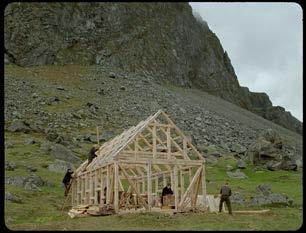

think we're up to 90,000 tickets sold.” That figure has since grown to more than 113,000.
As the car drives out onto the frozen ocean, Hlynur cautions: “It could break a little bit, but don't worry.” Now startled, my photographer companion and I hold on tight to our seats. “It's a very strange, but very beautiful place.”
a tour. “This is the church. It was built from the ground up and you sort of see that process in the film,” he says. As we step inside, the strong wind gives the church a good shake, making its walls tremble.
Hlynur shows us around the merchant’s house that looks too good to be a prop. The crew also built a vegetable garden and chicken coop.
“We actually transported my chickens here. I was a little bit afraid because there are foxes,” he says, pointing in the direction of the mountains.
“I really like writing and filming at the same time,” Hlynur shares. “There’re a lot of scenes that take a long time to film, for example, there's a scene with a horse rotting. I shot that for two years while I was writing the project.”
A tale of opposites
Despite a disclaimer explaining the film was inspired by seven photographs taken by a Danish priest, Hlynur says the story is entirely fictional. “A lot is taken from life itself, experiences and details from travel journals.”
“I went back in time to explore these two countries and their relationships because we were under the Danish crown until 1918. I wanted to explore that period, but at the same time, I wasn't focused on something specific,” he says. “Sometimes I was just thinking, ‘We have a young ambitious priest. What's the opposite of that? Ragnar, the man of nature.’ I was basically just putting opposites together.”
Three titles, one film
“Godland,” also known as “Volaða Land” in Icelandic and “Vanskabte Land” in Danish, has different meanings behind its titles.
“The name ‘Volaða Land’ comes from a poem by Icelandic priest Matthías Jochumsson who studied for the priesthood in Copenhagen,” Hlynur explains. “He moved up north after he came from Denmark. He experienced a harsh winter in Akureyri when the whole fjord froze. During the next summer, it wasn't warm enough, so the fjord stayed frozen. He wrote this hateful diatribe about Iceland — a very aggressive poem called ‘Volaða Land,’ which means violent, wretched, disfigured island.”
According to Hlynur, the poem was published without the priest’s knowledge. Matthías faced public backlash and had to write another poem about the beauty of Iceland to restore his reputation.
“That poem was a big inspiration for the film,” Hlynur admits. “The Danish translation of ‘Volaða Land’ is ‘Vanskabte Land.’ It's a very strange translation but a very beautiful one. It's very expressive, almost more brutal than the original.” He continues: “The English title, ‘Godland,’ is very different from the original title. I always felt like if you put ‘Volaða Land,’ ‘Vanskabte Land,’ and ‘Godland’ together, they give you a good picture of the film.”
Hlynur Pálmason postponed our interview at least four times . I knew he was busy travelling to festivals with his new movie, so when I found myself at one festival and saw “Godland + Director’s Q&A” in the programme I immediately texted Hlynur a hopeful “See you there.” His response came dryly: “I had to cancel the trip. Enjoy the festival.” As months went by, the film’s Icelandic premiere kept getting postponed and every time I mentioned the film to my editors, they rolled their eyes: “You, and your ‘Godland’ saga. It’s not gonna happen.”
I had started to lose hope. That is, until the day I found myself standing outside Hlynur’s home on the outskirts of Höfn. The weather was crisp and beautiful, and Hlynur’s kids were getting ready to go ice skating. I felt guilty for stealing their dad for an interview. Also, there was one problem — I still hadn’t seen the movie.
A carpool with the director
“Maybe that's the whole interview. You haven't seen the film,” smiles Hlynur as I hastily mention this point and apologise while we drive to one of the main filming locations.
Hlynur’s third feature, “Godland” has certainly captured the world’s attention, receiving numerous awards and nominations, including Elliott Crosset Hove’s European Actor nomination at the European Film Awards.
“I think it's been a slow build for us,” shares Hlynur. “I like things that grow slowly. We're really happy that it's been received so well.”
“It's not a mainstream film, but at the same time, it's been doing things that none of my films have been doing,” he adds. “For example, in France, I
Godless wasteland
“Godland” explores Iceland’s colonial past through the eyes of a young Danish priest, who travels to the island to build a church and immediately finds himself facing the harsh environment and a language barrier.



“I was exploring the two countries that I know very well,” says Hlynur. “I grew up here in Höfn and then I moved to Denmark. I studied, had children and lived there for a long time. I wanted to look at and explore the history Denmark and Iceland have together.”
As we approach the film set, the magnificence of the scenery outside the car windows has us in a state of awe, but at the same time we’re fully aware of the uncompromising nature of the surrounding rugged mountains, powerful waves and harsh winds.
“We always said to ourselves — ‘We are slaves of the weather,’” Hlynur reminisces. “When planning a film, one of the most important things is that everything is planned with the locations and weather in mind. For example, if we're shooting the first part of the film, I have to shoot it chronologically, and we have to have all of the actors accessible during the whole period.” He smiles:
“This is very different from normal. When you make films, you get an actor for three days or something to shoot all of their scenes. I can't work like that. I have to have them the whole time.”
The church that trembled
We arrive at the set and Hlynur gives us
These opposites can be seen throughout the film — the colours of the Danish flag against the Icelandic flag, the ongoing verbal battles in Danish and Icelandic, the juxtaposition of a Danish hymn against the Icelandic landscape.

Family business
Reflecting on the importance of seeing beauty around you, Hlynur says: “I don't think you always have to go so far. Sometimes you can see it in the people around you or just in your back garden.”
“It's a very personal film. It's not about my life, but it's very personal. It’s so homemade,” he shares. “Even the extras in the film are people I know.”
Hlynur’s daughter Ída Mekkín stars in the film and it’s not the first time his kids appear on screen. “It's very natural for me to invite them into the process,” he explains. “My daughter has always enjoyed performing. She takes it very seriously. With the boys it's a little bit different. They're more just along for the ride.”
Hlynur agrees he has never been one of the dads who set a clear boundary between work and life. “I can write when my kids are crawling on my head,” he laughs. “I've always done it like that. When you make a film, the temper of the film very much reflects where you are in life, how you see and hear things.”
Disposable things
Back in the car and driving away from the set, we talk about the clamour of modern life, AI, and single-use objects. “Today, things are normally like this — disposable, very fast,” Hlynur says. “A lot of cinema and food is made that way. I think AI will make the personal and handmade [things] even more important, it will underline them.”
“I don't have any socials. My phone is like this,” he points at the only two apps on his phone — for calls and messages.
“I can't even go on the internet. I really like being in my head, imagining things and thinking about things.” He admits that staying off-the-grid helps him to filter the outside noise.
A month later, as I sit in an otherwise empty cinema for a special screening of “Godland,” I remind myself of this conversation. Despite the unpredictable weather conditions, challenging terrain and isolation of Iceland, the priest, worn out mentally and physically, is destined to stay here. And so is Hlynur. “I love it here. I wouldn't want to be anywhere else.”
18 The Reykjavík Grapevine 3/23 Best before: April 13, 2023 Culture/Film
Iryna Zubenko
Joana Fontinha Film stills: Maria Von Hausswollf “Godland” premieres (finally) in Smárabíó, Háskólabíó and Bíó Paradís on March 10.
Words:
Image:
Björk announces concert in Reykjavík
Björk Guðmundsdóttir will host three separate concerts at Laugardalshöll June 7, 10 and 13 as part of her Cornucopia tour. Incorporating her trademark musical and theatrical production, Björk fuses the worlds she created for her last albums, Utopia and Fossora, creating a once-in-a-lifetime sonic and visual experience. Having been described as “digital theatre” and “a sonic feast” by critics, this is an opportunity not to be missed. Tickets range from 19.990 to 34.990 ISK and are available at tix.is.

Iceland
Airwaves
announces first additions to 2023 festival lineup
Iceland’s most prestigious music festival, Iceland Airwaves, has announced the first round of confirmed artists for its 2023 iteration. Among the first acts to be announced are Balming Tiger, Blondshell, Cassia, Clubdub, Daniil, FETISH, Fran Vasilic, Gallus, Kristin Sesselja, Kneecap, Lime Garden, Lón, Love’n’joy, Myrkvi, Nanna, Neonme, Squid, The Goa Express, The Haunted Youth, Trentemøller, Whispering Sons, and Yard Act. Tickets are available at IcelandAirwaves.is.
Post-dreifing’s Hátí ð
ni festival opens for artist submissions
Reykjavík’s favourite DIT collective, post-dreifing, announced their open-call for artists interested in performing at their annual Hátíðni festival in Borðeyri. Submissions are open until April 1. First-time performers are encouraged to apply, as well as anyone who can create an iconic Hátíðni moment.


Hátíðni festival is the annual celebration of the Icelandic experimental, and irreverent music and art performances. The festival will take place June 30 to July 2, with ticket information to be announced soon.
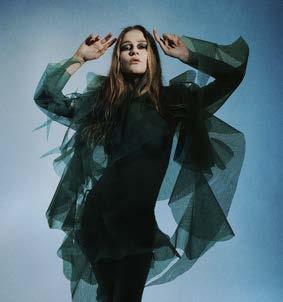
Misþyrming Returns With Blunt Force

A Q&A with black metal royalty
In December 2022, the Reykjavíkbased black metal band Misþyrming released their new album Með Hamri. The title translates literally to “With Hammer” and, just like a hammer, it hits. Violently. In this first edition of the Grapevine’s Filthy Interview series, Mis þ yrming guitarist, vocalist and producer D.G . explains what the new album represents as the band marks a decade of darkness.
Nasa venue formally re-opens
Iconic nightclub Nasa has formally reopened. The venue was first closed in 2012, then opened for a hot minute before being torn down in 2018. At long last, it has been officially opened as part of the new Iceland Parliament Hotel, now that everyone has forgotten what the big deal was. The club itself has been constructed underground, within the hotel that encompasses it. Local country band Sycamore Tree inaugurated the sunken venue with a special Valentine’s day concert. Tickets for that gig cost 6.900 ISK, but let’s hope the next show won’t empty our purses.
Me ð Hamri came out three years after your previous release Algleymi . What is the concept of the new album? It is a very aggressive and bitter manifesto. I am not going into the meaning of the lyrics because it would be like explaining a joke, everyone can give their interpretation. It’s hateful, like black metal should be. Extreme music needs to be extreme and that was the goal of this album. Our last album Algleymi, released in 2019, was more emotional. This one is just furious, with dark soundscapes across music and lyrics. It is definitely our darkest album yet. In Algleymi we wanted to make a cleaner sound. With Með Hamri, we decided to go back to where we
were at the end of the first album, Söngvar Elds Og Óreiðu. It was so powerful that we could barely control it, maybe also because we were less experienced. Through the new album, we had to make a statement. A tribute to our darkest roots.
What was the process involved in the making of the album?
I finished writing Algleymi at the end of 2016 and I couldn’t write anything for three years after that. You can’t really put your head into the next project until everything related to the release is finished. I am talking about shows, tours, promotional stuff and such. I have a chaotic mind, but I managed to slowly get the writing process into my routine. After two years, I managed to write a bunch of songs and eight ended up on Með Hamri Then, we started recording it a year ago. We changed drummers because our former drummer was living abroad, and the long-distance relationship unfortunately didn’t work. It was a drama-free decision, and we hired Magnus from Svartidauði. We recorded the drums in Stúdio
Sýrland in one day. The rest of the album was recorded at the black metal headquarters, somewhere in the suburbs of Reykjavík.
We had deadlines for Með Hamri because the vinyl production got altered during Covid. We worked on it non-stop between March and July 2022. The vocals were the last thing we recorded and I was also in charge of mixing through this last stage. We used extremely loud amps and the pace of the music was very fast. When we nailed something we would blast it, then just sit and listen.
Can you tell us anything about the album cover for Me ð Hamri ? What’s it about?

The main point of this fenced temple is to be majestic and at the same time unwelcoming. We wanted to create an atmosphere of fear and respect around our art. We don’t want to sound pretentious, so it’s important that we differentiate between Misþyrming and the egos of band members as individuals.
What’s next for the band?
The release show is happening March 31 at Iðno. Other than that, we are going to play in many festivals this year and we are going on a mini tour in Australia this summer before embarking on another tour in Europe by the end of the year. Then, of course, we are always working on new stuff.
Tickets to the Með Hamri release concert on Midix.is.
Buy the album at misthyrming.bandcamp.com
Or stream it on all platforms
19 The Reykjavík Grapevine 3/23 Best before: April 13, 2023
Culture/Music
MUSIC / FILTHY INTERVIEWS
Words: Francesca Stoppani Image: Marton Bodnar
CENTRE MAP
The City Map presents a selection of restaurants, bars and shops that received the 2022 “Best Of Reykjavík” award curated by our stringent panellists. Get the bigger, more detailed version of The Reykjavík Grapevine City Map at your nearest hotel or guesthouse.
Dining


1. Le Kock Tryggvagata 14
The craft burger OG has never been better. No one toasts potato buns to crisp perfection like they do, or cooks patties to such medium rare goodness. Everything is made from scratch, including the condiments! This is gourmet fast food, with all of the attention to detail and none of the sacrifice on fun and flavour.
2. Flatey Grandagarð ur 11
Educating a country beyond their diet of pizza-chain pies is no small feat, but that’s exactly what Flatey sought to do when they burst onto the scene, and for that we applaud them. The Margherita continues to be a panel favourite; who can argue with milky mozzarella and tomatoes?
3. Fine Rau ð arárstígur 33
A panel favourite, Fine is a no nonsense, no frills, Sichuanese Chinese restaurant that steadfastly opens Reykjavík’s mind’s and palates to the regional cuisine. The Mala Chicken is a tingling explosion of flavour, literally, thanks to the sichuan peppercorn. For something simple yet exciting, we recommend the Hot and Sour Potatoes.
4. SONO matselijur Sæmundargata 11

Sono overlooks a wild-flower meadow and a spectacular view of the Reykjavík skyline. Languorous and idyllic, the menu too is shaped for slow savouring. The chefs look beyond Iceland for inspiration, while still showcasing seasonal, local produce in all its colourful glory. Foraged herbs, berries, fruits, stems, and flowers all feature on the menu, resulting in a fun affair that serves as a reminder that good vegan food goes beyond batter fried cauliflower.
Laundromat offers a cool ‘50’s-dinermeets-maximalist-library vibe, decorated with bright furnishings, maps and colour-coded books. It’s great for families in general, but teens in particular like the fun decor, burgers and milkshakes. We especially love their vocal support for breastfeeding, as well as the fact that you can actually do laundry here.
Deig’s ‘poor man’s offer’ is as good as it gets on this abnormally expensive
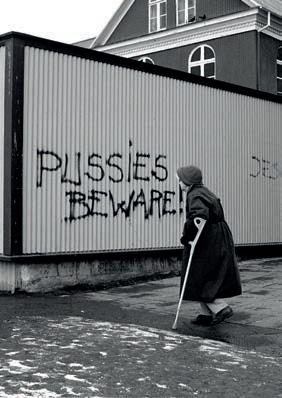
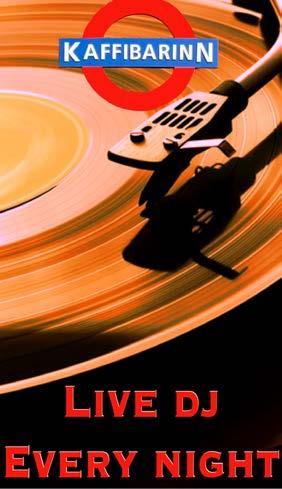
island. For 1500 ISK, you can choose from a handmade bagel with a filling of your choice, any doughnut or pastry from their selection, and a simple drink (coffee, juice or kokomjölk, basically). Even better, they open at 7 a.m., and the offer is valid every weekday, for as long as the bakery is open.
7. Sushi Social

Drinking
12. Röntgen Hverfisgata 12
This place has it all. “It’s crazy how it’s continued to dominate the bar scene in Reykjavík,” one panellist raved. “But it’s just got so many elements.It works for every vibe, which is so rare for a bar.” Despite only appearing on the downtown scene a few years ago, the place has already cemented itself among the nightlife legends.
13. Jungle Cocktail Bar Austurstræti 9
5
If you are a group of friends looking for a fun night about town, Sushi Social is the place to be. The menu is ideal for sharing—although, who’d want to share something as delectable as langoustine tempura. Order one—or several—of those colourful drinks with names that recall a tropical holiday to make a fun night even more festive.
8. Sumac Grill & Drinks Laugavegur 28
Sumac is one of the few places that cooks lamb with none of that sous-vide nonsense. An unpretentious lamb rib, cooked on the grill, kissed with smoke and licked by flame is pretty hard to top. Sumac serves it with blistered grapes, fried almonds, a splash of thinned down muhammara and lentils. It’s a dish you can’t get enough of, and thankfully the restaurant hasn’t dared to take it off the menu.
9. Borg 29 Borgartún 29
This is one of the more comfortable food halls to be at, with a wide variety of choices to please most anyone. “Almost every place makes small plates, which is excellent for sharing,” observed one panellist. She’s right, one can choose from sushi at Umami, to burgers at Yuzu, to grilled meats at Bál.
10. Fish Company Vesturgata 2 a
For the definitive seafood experience in Reykjavík, you’d be hard pressed to find a better spot than Fiskfélagi ð Their tasting menus are a great way to try the best Icelandic waters have to offer, from Atlantic cod served Japanese style, to harissa wolf-fish. The sushi platter makes for a great lunch while their fish of the day is usually a generous pan-fried dish with a luscious sauce.
11. Þrír Frakkar Baldursgata 14
This cosy, tucked-away restaurant has not let anything sway them from tradition—you’ll spot everything from foal, to blackbird, to cod throats to plokkfiskur on their menu. Opened in 1989, the restaurant has been run by chef Úlfar Eysteinsson and his family ever since. A visit to this place underlines that good old-fashioned Icelandic cooking can be all kinds of memorable.
“Jungle’s vibe naturally caters to an early night crowd. It’s stylish and airy, and, of course, they have the most innovative and delicious cocktails in the city,” enthused one panel member. The panel also praised the bar’s diversitynoting how attendees spanned all ages and demographics.
14. Kaffibarinn Bergsta ð astræti 1
Let’s be real: there’s a reason that Kaffibarinn is still here and full of dedicated regulars. At night, you’ll find the crowd gets rowdy, the convos get interesting and the dance floor gets sweaty in the most wonderful way. “It’s the obvious choice,” said a panellist. “Who doesn’t have some crazy story from closing time in the smoking area at Kaffibarinn?”
15. Gaukurinn Tryggvagata 22
With dim lights, leather sofas, genderneutral bathrooms and free tampons, this bar/venue is the preferred hangout for the unorthodox Reykvíkingar. So if you’re looking for like-minded alt/ queer peeps, there you go. From heavy metal fests to quieter indie shows, this second floor haunt does it all.
16. Bravó Laugavegur 22
Bravó: a dark room with ambertoned light, simple furniture, and cosy bohemian pillows. Their happy hour—perhaps the most prolific in the city—starts at 12:00 everyday and lasts until 20:00. Located in the heart of Laugavegur, it’s also a prime peoplewatching spot.
17. Óðinstorg
Ó ð instorg
It’s decided: Ó ð instorg is the best outdoor drinking spot in Reykjavík. The new square was previously a parking area, but is now an open, airy, designed-for-those-lazy-summerdays paradise. You have good sun, good seating, Snaps, and Bodega, and serious mainland European vibes.
18. Session Craft Bar Bankastræti 14
With its minimal appearance, stainless steel bar backed with dozens of taps and fridges full of beers canned and bottled, Session is a place that, while cosy enough, is made for serious craft heads. Whether you’re hankering for a lip-puckering gose, or an IPA packed with more flowers than a funeral, Session has got your back.
VESTURGATARÁNARGATA ÖLDUGATABÁRUGATA TÚNGATA TÚNGATAMARARG. SÓLVALLAGATA SÓLVALLAGATA HOLTSGATA HÁVALLAGATA HOLTSG. ÁSVALLAGATA REYNIMELURVÍÐIMELUR ARAGATA ODDAGATA ARSTÍGUR BRÆÐRABORG SELJAVEGURFRAMNESVEGUR ÁNANAUST GRANDAGAR FISKISLÓÐ SUÐ LJÓSVALLAGATA HÓLAVALLAG. SÆMUNDARGATA FURUMELURBIRKIMELUR ESPIMELUR ÆGISGATASTÝRIMANNASTÍGUR SUÐURGATA HRINGBRAUT FÁLKAGATA STURLUAGATA AGAT MÝRARGATANÝLENDUGATA Nordic House Culture Center University of Iceland National museum National library Hólavallagarður Cemetary Maritime Museum FlyOver Iceland Saga Museum Aurora Reykjavik 2 I H G F E D C B A
5. Laundromat Austurstræti 9
6. Deig Workshop Tryggvagata 14
Þ ingholtsstræti
Klappið app
The official ticketing app for public buses in the Reykjavík capital area
VÍNSTÚKAN Wine bar & food 1 2 4 PHOTOS FROM ICELAND Skólavörðustígur 22 C G B A
Search for "Klappid" in the App Store or on Google Play.
Downtown & Harbour District
� In more ways than one �
NJARÐARGATA
Shopping
20. Yeoman Laugavegur 7
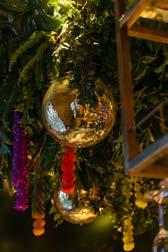



2021 saw Yeoman being donned by international celebrities while also continuing her reign as the primary fashion tastemaker for Reykjavík women.“To talk about modern Icelandic style is to talk about Yeoman,” one panel member said.

Clothing Swap Club!
Elvira 101 Klapparstigur 5

Hitting two birds — fashion waste and economic inflation — with one stone, the new clothing swap-concept store Elvira 101 is bringing a fresh and eco-friendly reenvisioning to the way we shop. Operating on a monthly membership model where people get points in exchange for clothes, the shop is a space where one can both drop off their old (but in clean and good condition) clothes and grab a bunch more for a monthly fee of just 4,900 ISK. No need to get attached to an outfit, just keep it clean, bring it back and grab something new. RX
Lucky Records is the one-stop-shop for anything Icelandic music. They’ve got it all; new titles, CDs, rarities, vinyl, cassettes, second hand 12 ”, 7” sections, you name it! Notably, the store is very in touch with the local underground. Basically any Icelandic release—no matter how big or small— will be sold there, and trust and believe, their shopkeepers will know them inside and out.
Similar to a consignment shop, Hringekjan is a space where people can rent out spaces to sell their own clothes and accessories. It’s the most eco-friendly way to keep your closet fresh, which, in light of our current world, is something we should all be thinking about. “I don’t know how they get such chic people to sell their clothes there,” laughed one panel member. If you want something groovy
Apótek Atelier is quite new on the scene, but this small boutique has already made quite a splash. Created by designers Ýr Þrastardóttir, Halldóra Sif Gu ð laugsdóttir and Sævar Markús Óskarsson, Apótek Atelier blurs the line between studio and store, functioning as both the designers’ workspace, as well as the place where one can purchase their wares.
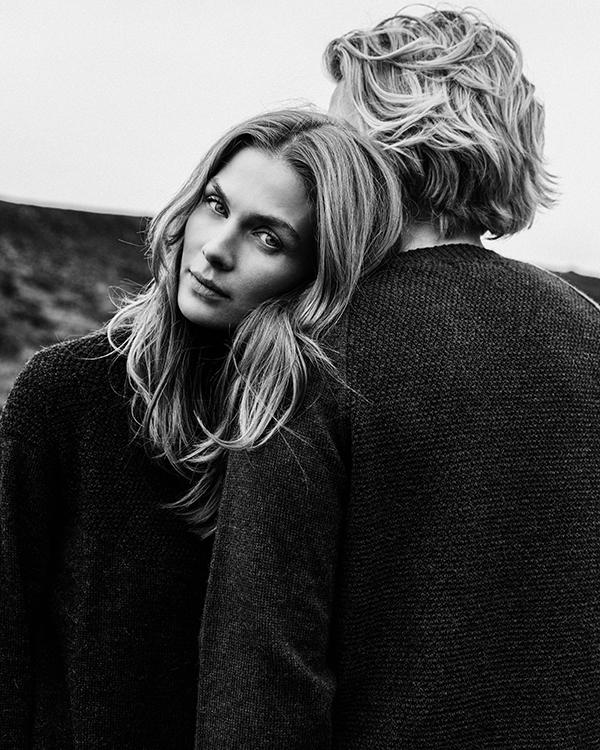


FRAKKASTÍGUR
BANKASTR. AUSTURSTRÆTI SKOTHÚSVEGUR TRYGGVAGATA GEIRSGATA VESTURGATA KIRKJU GRANDAGARÐUR TJARNARGATASUÐURGATA AÐALSTR. GARÐASTRÆTI GRETTISGATA
NJARÐARGATA
BERGSTAÐARSTRÆTI FR ÍKIRKJUVEGUR P ÓSTHÚSSTRÆTI
ÓÐINSGATA
BARÓNSSTÍGUR SNORRABRAUT
BARÓNSSTÍGUR
NAUTHÓLSVEGUR VATNSSTÍGUR KLAPPARSTÍGUR BERGSTAÐ ARSTRÆTI
LÆKJARGATA INGÓLFSSTRÆTIÞINGHOLTS STRÆTI
ÞÓRSGATA VONARSTRÆTI LOKASTÍGUR BALDURSGATA BRAGAGATA VITASTÍGUR
SNORRABRAUT
SKÓLAVÖRÐUSTÍGUR ÁSLAUF VEGUR
NJÁLSGATA
MIKLABRAUT VATNSMÝRARVEGUR BÚSTAÐ AVEGUR HRINGBRAUT BERGÞÓRUGATA EIRÍKSGATA EGILSGATA HVERFISGATA LINDARGATA SÖLVHÓLSGATA SKÚLAGATA SÆBRAUT BORGARTÚN BRÍETARTÚN HÁTÚN MIÐTÚN SAMTÚN SÓLTÚN HÁTÚN LAUGAVEGUR LAUGAVEGUR FLÓKAGATA HÁTEIGSVEGUR SKÓGARHLÍÐESKIHLÍÐ BARMAHLÍÐ MÁVAHLÍÐ DRÁPUHLÍÐ VESTURHLÍÐ BLÖNDUHLÍÐ HÖRGSHLÍ AUTARH N ÓATÚN LANGAHL ÍÐ REYKJAHLÍÐ KRINGLUM RAUÐAR ÁRSTÍGUR RAUÐAR ÁRSTÍGUR ÞVERHOLT MJÖLNISH. ÁSHOLT STÚFH. TRA ÐARH. GUNNARSBRAUT NÓATÚN KATRÍNARTÚNI Þ ÓRUNNARTÚN STÓRHOLTMEÐALHOLT STANGARHOLT STRÆTI SKÓLABRÚ LAUGAVEGUR BR OLT HRINGBRAUT SKIPHOLT HAFNARSTRÆTI BSÍ House Center Austur völlur Icelandic Parliament Eagle Air Terminal Hlemmur Food Hall Sundhöllin Swimming Pool Landsspítali Hospital City Hall Hallgrímskirkja Church Listasafn Einars Ásmundasalur National Theatre The Culture House Bíó Paradís Reykjavík Art Museum Marshall House Grandi Mathöll Harpa Concert Hall Kjarvalsstaðir Museum Hljómskálagarður Park National Gallery 3 4 5 6 7 8 9 C 3 23 19 A D B 6 5 13 21 7 16 15 14 22 10 12 20 24 24 8 18
LAUFÁSVEGUR FJÖLNISVEGUR FREYJUGATA SÓLEYJARGATA
GAMLAHRINGBRAUT
23. Apótek Atelier Laugavegur 16
21. Lucky Records Rau ð arástígur 10
22. Hringekjan
Þ órunnartún 2
New In Town 17 1 11
9
WW W.A S WE GROW.IS D
Culture/Listings

March 3 to April 13
Art Exhibitions
Gallery openings, happenings, showings and pop-up exhibitions all around the capital region.
Galler ý
Gallery of Iceland
Jónsson Museum
Fold
Skilti
Center of Culture and Fine Art
Tickling the Ivories
It’s the Battle You’ve Been Waiting For
Are You Ready for Some Metal!?
Come to Piano Day 2023 on March 29 and experience the magic of the piano through the unique sound and creativity of acclaimed composers Miro Kepinski, Sævar Jóhannson and Eðvarð Egilsson, as they release their new music. Don't miss this opportunity to immerse yourself in the beauty and versatility of the piano and its music! GVDM
Mark your calendars for the 2023 Músíktilraunir — the ultimate destination for music lovers! The semifinals will be held March 25 to 28, followed by the announcement of the results on April 1. Young musicians between the ages of 13 and 25 will grab their chance to shine on the big stage! With around 40 bands vying for an opportunity to perform on the final night, the festival promises to be an extravaganza of musical talent. GVDM
Get ready for an electrifying night of metal as Hellirinn Metalfest returns for another epic round, brought to you by the powerhouse collaboration of Doomcember and Eistnaflug. On March 25, HM-2 will ignite the Hellirinn (Tónlistarþróunarmiðstöðin) stage with an incredible line-up of six diverse bands. Don't miss this opportunity to experience the raw energy of live metal music and show your support for the rising stars of the metal world! GVDM

City Library - Grófin
Museum of Photography
Who Rocks? Jack Rocks!
Get ready to rock at the Jack Rocks Festival, in collaboration with Gaukurinn! This explosive two-day event showcases some of the most talented and popular names in the Icelandic rock scene. We’re talking Vicky, Power Paladin, Noise, Volcanova, Múr, Flesh Machine, Ormar and Líkami. Woah! Buy your tickets now and get ready to have your mind blown by the amazing performances! GVDM

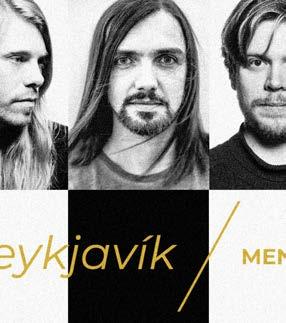
22 The Reykjavík Grapevine 3/23 Best before: April 13, 2023 SÍM
⮕ ⮕ National
⮕ ⮕ ONGOING Ásmundarsalur ⮕ ⮕ Ásmundarsafn ⮕ ⮕ Einar
⮕ Gallerí
⮕ Gallerí
⮕ Hafnarborg
⮕ ⮕ Hafnarhús ⮕ ⮕ ⮕ ⮕ Harpa ⮕ i8 Gallery ⮕ Kjarvalsta ð ir ⮕ Mosfellsbær
⮕ Museum of
⮕ ⮕ ⮕ National Gallery of Iceland ⮕ ⮕ Nordic House ⮕ Reykjanesbaer
⮕ ⮕ Reykjavík
⮕ Reykjavík
⮕
⮕ ⮕ Sumac
⮕
Art Gallery
Design and Applied Arts
Art Museum
Sigurjón Ólafsson Museum
Restaurant
OPENING Ásmundarsafn ⮕
⮕ ⮕ Gallerí Fold ⮕ ⮕ Gallerí Göng ⮕ ⮕ Gallery Grásteinn ⮕ ⮕ Gallery Ófeigur ⮕ ⮕
The Association of Icelandic Printmakers
Musical Storytelling On The Big Screen
Herdís Stefánsdóttir discusses her latest film score and taking a year off

Words: Jóhannes Bjarkason Image: Jeaneen Lund

It is 8:30 a.m. in Los Angeles when composer Herdís Stefánsdóttir logs in to meet with me virtually. With the latest winter storm bearing down on Reykjavík, Herdís retreated to sunny California, admitting “it was an attempt to escape the winter in Iceland.”
Herdís has just celebrated the release of her third feature-length soundtrack, this time for director M. Night Shyamalan’s newest horror offering “Knock at the Cabin.”
“It was absurd, but mostly exciting as I’m a long-time M. Night fan,” Herdís tells me. The opportunity to work with one of her favourite directors came as a surprise. “I just got a call from my manager. M. Night had heard my music and when we met on a Zoom call, he hired me on the spot. He was very nice and humble,” Herdís says.
Biblical composition
“Almost every project is different,” Herdís says of her creative process. “When beginning a new project, I‘m very dramatic and think that I can‘t write any more music. My work resonated with M. Night and the process started nicely. He gave me free rein.”
The production process introduced Herdís to some challenges presented by the continuous editing of the film, prompting her to return to the studio multiple times. “It was also a small team for a film of this calibre. Usually, it‘s a team of three to five individuals, but for this film, it was only me and my friend Úlfur Hansson.”
“It was an incredible experience. After it, I‘m like ‘OK, I‘m not afraid of anything.’”
Herdís drew inspiration from some childhood favourites, including Hitchcock and other 1960s horror classics. “My process is focused on diving deep into the story. Exploring the characters, the subplot and the backstory.”
“For Knock, I was reading the Book of Revelations, because the framework of the film is biblical. But you need to tell it without spoiling anything, or saying something completely obvious. Then I visualize all the details, and layer by layer I build something that‘s referencing older horror films while creating something completely new that‘s in line with the aesthetics, acting, backdrop, and everything.”
“Can you start Monday?”
Herdís began her career studying composition at the Icelandic University of the Arts, where she ended up collaborating with a number of different artists. “I have always been fascinated by storytelling in music, so I chose a master’s program that emphasised film scoring.”
From Reykjavík, Herdís moved on to New York University, where she met the late film composer Jóhann Jóhannsson, who received an Oscar nomination for the film Theory of Everything around that time. “They were hosting a screening of the film where Jóhann had a Q&A. My teacher approached
me, encouraging me to introduce myself. You know, because we‘re both from Iceland.”
After deciding against continuing her studies, Herdís began exploring other opportunities. “I remember contacting Jóhann when I was interested in moving to Berlin, seeing if he needed any help with his work.“ Jóhann refused the offer initially but left the communication open. “A few months later, I was on my way to Berlin when I decided to contact him again. ‘Hi, would you like to meet up for coffee?’ Jóhann replied. ‘No. Can you start Monday?’” At Jóhann’s Berlin studio, Herdís was introduced to film composers Hildur Guðnadóttir and Dustin O’Halloran.
Witnessing the success of Icelandic film composers in Hollywood in recent years, I asked Herdís for her thoughts on the trend. “Everybody knows each other and is friendly. It‘s inspiring when someone you know is doing well. When I saw Jóhann‘s name in a credit roll for the first time I thought, ‘It‘s possible. You know, why not?’”
A long-needed break
After working for four years as a film composer, Herdís is taking a much-needed break.
“I decided last year that I won‘t be committing to anything in 2023. I was just declining the biggest project I‘ve been offered. That was a ridiculous feeling. Now I‘m just reading books and going for walks. It‘s like being retired or something. I like not working.”
That break from film composition doesn’t extend to her solo project Kónguló. “I‘ve arrived at a place in my artistry where I‘m more confident in my work. What‘s most liberating is that I genuinely don‘t care what other people think. I‘m just exploring interesting dimensions that I find exciting both as a producer and songwriter. With my film career, I don’t have to depend on this being successful. I’m just doing exactly what I want.”
Knock at the Cabin is now in cinemas. Find Herdís’ original soundtrack on your preferred streaming services.
24 The Reykjavík Grapevine 3/23 Best before: April 13, 2023
CULTURE
Tracks Up My Sleeve
Words: Jóhannes Bjarkasson Image: Supplied by TSS
TSS is the solo project of multiinstrumentalist Jón Gabríel Lorange. The project’s fourth LP, Tracks up my sleeve, was released independently on February 1, continuing to display its use of minimalist soundscapes, synthesized instruments and catchy songwriting. The album explores the grooves that make your body move and dives into Jón’s latest relationships without demanding a lot from the listener — it’s just 20 minutes long, with three phone recordings falling well within the minute mark. We asked Jón to walk us through Tracks up my sleeve. Here’s what he has to say.
fyrsta lagi ð á nýju plötunni
“This is exactly as the title suggests. The album includes a few phone recordings and I found this moment a good time to play an idea of a song, which isn’t on the album though. On the recording, my wife Emma (who made the album cover) asks about a blinking light on the synth I’m playing.”
Stress
A mantra to combat stress, the song begins with deep breaths. Jón
says: “The main part of this song is a rather nervous dance beat where I sing about how stress isn’t good.” This boppy track sounds like a demo by LCD Soundsystem.
a taste for the demonic

An eccentric 32-second track, Jón plainly states: “There was some kind of an imp inside me when I made this song.”
þ ér ég ann
Jón says that the song was originally written by Ukrainian film composer Dimitri Tiomkin and is the theme to the film Friendly Persuasion. Jón bases his cover on the performance by Haukur Morthens from 1957, released as a B-side to the single Pep / Þér ég ann by Fálkinn Records. The song was released as part of his run-up to the album release.
automatic motions (john)
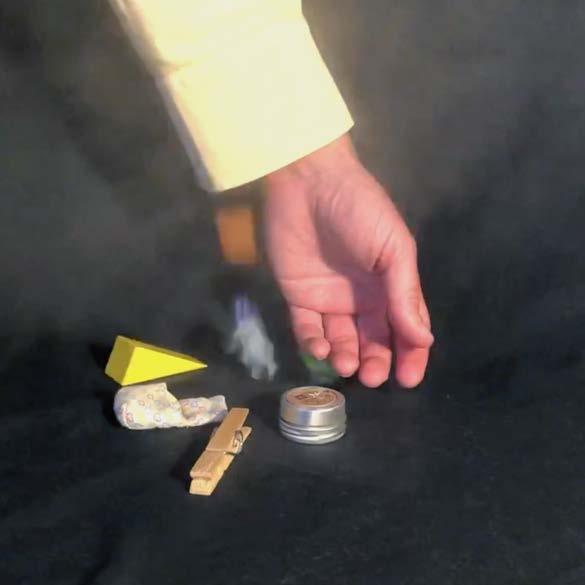
Sounds a bit like if Paul McCartney was given a Korg M-20 and locked in a room for 6 months while stuck in his Wings era. Jón says: “I once wrote a song I thought was a very Paul McCartney-esque, so I named
that song Paul. Then I realized I needed to be fair to the idols and wrote another song named John. I think this outcome resembles much more something by Harry Nilsson, so I’ve always called this the Harry Nilsson song.”
draugur
“This is the second phone recording on the album. Spooky!”
hristan
Another one of Jón’s previously released songs, hristan is an upbeat track about a shaker. “Hristan is just a fun rock song where I sing about a shaker. But you can also interpret it as if you should shake it,” Jón explains.

ebony
Jón says that he wrote this Cat Stevens-like acoustic ballad shortly after the birth of his daughter.
“She was born with black hair and blue eyes, which explains the ‘ebony’ part.” The song is about the newfound meaning you discover when having a child.
a simple love song
This track lists Jón’s previous band, Nolo, as the co-writer. “Me and my good friend Ívar Björnsson make up the duo Nolo. That band isn’t very active these days, but we meet every now and then for a jam. Even though we don’t meet for months, we are still able to write five songs every time. And I thought it was important to put one of them on the album. Maybe it will wake up an old ghost?”
gó ð a nótt
This bossanova style beat has Jón singing soothingly “good night”. “This is the third phone recording which I thought was perfect to end the album on. Like the other phone recordings, I never expected it to end up on a record. I was putting my child to sleep and had the idea to sing a lullaby to a bossanova beat — now everybody at home can sing, too.”
shop.grapevine.is shop.grapevine.is shop.grapevine.is shop.grapevine.is* shop.grapevine.is shop.grapevine.is Don't Hesitate! Act Now! You only need to type the URL in once Get Grapevine Merch! TRACK BY TRACK 25 The Reykjavík Grapevine 3/23 Best before: April 13, 2023 CULTURE
ð
Viðnám: Samspil myndlistar og vísinda Resistance: Interplay of Art and Science Free admission for children & teens 3.2.2023— 26.3.2028
Safnahúsi
The House of Collections
The Rocky Foundation of Law & Order
Exploring the past and imagining the future of Iceland’s Alcatraz


Travel doesn’t have to entail hitting the road, hopping on a plane or lacing up your hiking boots to trek into remote destinations. There’s something to be said for the staycation, or travelling in time by getting to know the places you might see every day a little better. With that in mind, Elías Þórsson takes us on a journey through the human history of places right here in Reykjavík.
In common Icelandic parlance, the phrase “að vera stungið í Steininn” (to be put into the rock) means to be imprisoned. The phrase is a reference to one of Iceland’s most remarkable buildings — Hegningarhúsið. The stone building at Skólavörðustígur 9 was built in 1872 and is also known as Steininn, in reference to the rocks that make up its outer walls, or Nían, a nod to its house number. From its inception through to its closure in 2016 it functioned as a prison, housing up to 23 inmates at a time.

Despite being located on Iceland’s most photographed street, Steininn routinely gets overlooked by tourists posing for photos with its younger and more famous neighbour, Hallgrímskirkja church. Chances are you’ve walked past it numerous times, not realising that you were passing Iceland’s version of Alcatraz and one of Reykjavík’s most important buildings.
The prisoner pen
“The construction of Hegningarhúsið was a watershed moment
in Icelandic architectural history,” says architect Hjörleifur Stefánsson. “It was the first time concrete was used for construction and marked the beginning of the trend of the rock cabins that used to litter Reykjavík.”
Hegningarhúsið was designed by the Danish construction official G. Ch. W. Klentz in a neo-classical style. Its layout is similar to prisons built elsewhere throughout the Kingdom at the time, but the building material makes it truly unique. The uncut stacks of rocks were pulled from the surrounding hill and they evoke the old Icelandic livestock pens that still dot the countryside.
Behind the building is a large enclosed courtyard where once prisoners would smoke, play basketball or just listen to the mundane, free city life on the other side of the imposing grey walls.
“It is one of the most beautiful houses built in Reykjavík from that time and its history is tied to the fate of so many Icelanders. It was groundbreaking in regards to construction technique and it is a momentous part of the history of law and order,” says Hjörleifur.
Spare the rod
Despite being one of Reykjavík’s oldest buildings, it was not the city’s first prison. A century earlier, the King of Denmark decreed that a place to house inmates was needed in the country and in the winter of 1770-71 “Múrinn” (The Wall) was erected. Today, Múrinn is the Lækjargata offices of Prime Minister Katrín Jakobsdóttir, but back then it housed criminals that the authorities rented out as slaves to various manual labour projects. However, after half a century of
infamy, financial problems in Denmark caused by the Napoleonic wars forced authorities to shut down Múrinn in 1816 and release all its prisoners.

Corporal punishments had been outlawed in the Kingdom of Denmark, but due to Iceland’s now acute lack of prisons an exception was made for the country to continue using beatings for the betterment of its people. Sentences equaling three years or less in other parts of the Kingdom were punishable by lashings, while more serious offenders were be sent to Copenhagen to serve time.
“This was rather embarrassing for Icelanders as all our neighbouring countries had stopped using physical punishments,” says Hjörleifur. “A cultural shift was
also happening around Europe at the time as authorities started to focus on rehabilitation rather than punishment.”
It was this sense of embarrassment that led to the construction of Hegningarhúsið
Three in one
Following trends in Denmark at the time, Hegningarhúsið was designed to house not just prisoners, but also the municipal government and the courts. On the ground floor was the prison, while city officials and the Icelandic supreme court had their offices on the second floor. Its construction wasn’t, however, without controversy.
“Many town halls across the
26 The Reykjavík Grapevine 3/23 Best before: April 13, 2023
Time Travel
Words: Elías Þórsson Images: Art Bicnick
Prisoners were not made to bathe when they arrived and an overwhelming putrid odour of human waste and filth permeated the halls
continent also served as prisons, but they tended to be in the centre of cities,” explains Hjörleifur. “Hegningarhúsið, however, was built outside of [central] Reykjavík and editorials at the time were quite scathing in their mockery of its location.”
Construction, however, was finished in record time and just a year later the nation was ready for its second attempt at a modern justice system. The municipal government stayed until the 1920s and the supreme court moved out in 1949, but the prison wasn’t going anywhere.
The odour of the past
Guðmundur Gíslason became director of Hegningarhúsið in 1985 and remained in charge until it closed its doors in 2016. He began working there during his summers as a university student in 1975 and he remembers the prison as a place that seemed to exist outside of time.
”Walking through the doors was like travelling back in time. The rooms had these wooden beds that wouldn’t have been longer than 1.6 metres, which meant that most men had to curl up in a ball to sleep,” says Guðmundur. “The cells had no toilets and prisoners weren’t allowed out at night, so they had to do their business in chamber pots.”
Prisoners were not made to bathe when they arrived and an overwhelming putrid odour of
human waste and filth permeated the halls, according to Guðmundur. Little to no maintenance had been done in the century since the first prisoners arrived in 1875 and the building, along with the institutional culture therein, were in dire disrepair.


“You got a sense that this was how prisoners had done their time a hundred years ago,” says Guðmundur. “Prisoners were kept isolated in their cells for most of the day and all phone calls and visits were closely monitored by the guards.”
A prisoner’s penance
In Europe, the term “rehabilitation” was always closely related to Christian penance and this had carried over into Icelandic prison culture.
“There was still this sense that isolation was positive and this 19th century idea that a prisoner should spend his time alone with his God. There were no televisions or radios and the only books that were allowed were the Bible and other Christian writings,” Guðmundur recounts. “Even the newspapers were censored to make sure the prisoners weren’t exposed to hazardous materials, so all articles about violence or crime were cut out.”
Despite the crummy conditions, not everyone was adverse to spending nights in Steininn. Guðmundur explains that the majority of the prison’s population back
then wasn’t actually made up of bonafide criminals, but rather the city’s more unfortunate souls
“During the winter months it was like a merry-go-round of the local drunks. They’d know what they needed to do to be imprisoned, so we’d lock them up for a couple of days. There they could sleep indoors, get a meal and stay warm and then they’d be released and be back on the street to repeat the process all over again.”
Around 1980, things began to change. The inauguration of homeless shelters meant that local drunks no longer had to depend on incarcerations for warmth. New leadership at the prison meant an improved selection of literature and diminishing fervour for isolation. But changes outside the prison bars were making work at Nían increasingly problematic.
Under party siege
In 1875, Skólavörðustígur was on the outskirts of Reykjavík, but as the years went by it found itself smack dab in the heart of downtown.
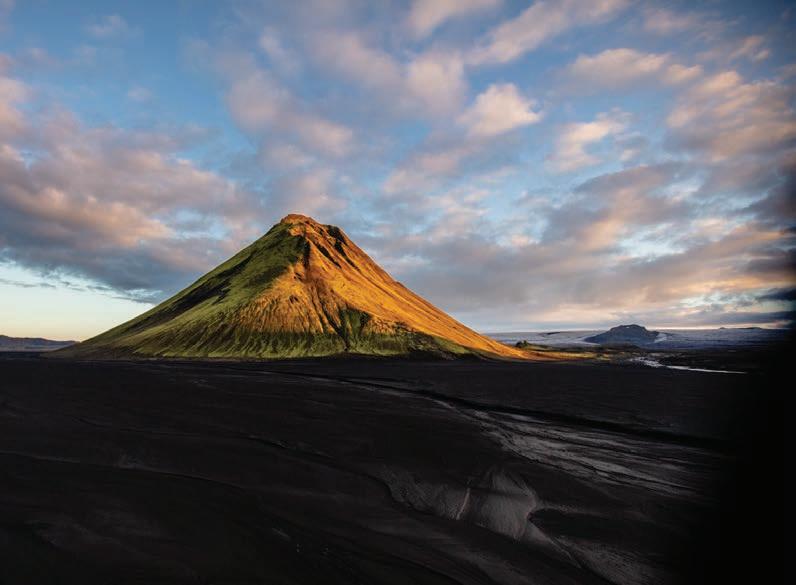

“In later years especially, the prison was surrounded by the country’s biggest party area, which made its existence a bit strange. Kaffibarinn is right next
door and Ölstofan is built right into the courtyard wall. I’m sure it will have made the punishment more unbearable for some to be surrounded by all this partying.”
Proximity to nightlife also brought out a philanthropic streak in the local population.

“You would regularly get people throwing beer cans and other alcoholic beverages over the walls to ‘give the prisoners something to drink,’” says Guðmundur with a smile. “There would also be attempts at smuggling drugs in by chucking it into the courtyard.”
The increasing impracticality of its location, coupled with 200 years of neglect, meant that Hegningarhúsið’s role as a functioning prison became ever more untenable. Thus, on June 1, 2016, at 10:50 a.m. the last prisoner left his cell.
The future is unwritten
Today, Hegningarhúsið stands empty and, since 2020, has been undergoing extensive renovations. The government organisation Minjavernd is in charge of the project and, according to their timeline, we are still years away from returning the building to a functional state.
“We are looking at two years minimum until we can expect work
to finish,” says Minjavernd director Þorsteinn Bergsson. “What comes after that is undecided, but there is widespread agreement that Hegningarhúsið’s door will be open to the public.”
Among the ideas being floated is turning the cells into workspaces for artists and the bigger rooms into gallery spaces. Another is to open a bar or a concert venue in the courtyard and to have a museum of law and order on the second floor. The location that seven years ago made it impractical as a prison, makes its potential as a cultural venue priceless.
“Hegningarhúsið is on one of Iceland’s busiest and liveliest streets … and it surprises you when you realise just how sizable it and the courtyard are,” says Þorsteinn. “You can easily picture it becoming an oasis right in the heart of the city.”
In 2025, it will be 150 years since Hegningarhúsið locked up its first prisoner. It would befit its illustrious and somewhat infamous history to make that the year it sells its first criminally overpriced beer. God knows Reykjavík could use a better place for quiet penance than Hallgrímskirkja.
27 The Reykjavík Grapevine 3/23 Best before: April 13, 2023 EXPLORE UNSEEN ICELAND ON THE ULTIMATE FLYING RIDE OPEN EVERY DAY | flyovericeland.com MUSEUM OF DESIGN AND APPLIED ART GARÐATORG 1 210 GARÐABÆR OPEN TUE–SUN 12–17 WWW.HONNUNARSAFN.IS Instagram Facebook honnunarsafn EXHIBITIONS HÖNNUNARSAFNIÐ SEM HEIMILI AT HOME IN THE DESIGN MUSEUM OPENS 27.01. THE PLATFORM BEST BOOK DESIGN FROM ALL OVER THE WORLD 2022 OPENS 20.01. RESIDENCY ADA STAŃCZAK CERAMIC DESIGNER OPENS 20.01.
Time Travel
“The construction of Hegningarhúsið was a watershed moment in Icelandic architectural history.”
A great selection of design and local craft



We're All Going Down Into the Lava Tunnel and Its Deep Secrets
Words: Lea Dörschel
Images: Art Bicnick

Let me take you on a journey back in time — about 5000 years back, to be precise. We find ourselves in Iceland, not too far from where the modern day city of Reykjavik stands today. But there are no human inhabitants. Only you, the gorgeous nature and calming silence.
Suddenly, the earth begins to shake and a massive fissure opens up in the ground. It spews molten lava in all directions, eventually creating an expansive lava field and beautiful formations the size of the city district of Barcelona. Located only 10 km south of the now dormant volcano, is today’s stunning destination, Raufarhólshellir – better known as the Lava Tunnel.
At 1360 metres, it’s one of Iceland’s longest caves and it has played a significant role in more than one movie and TV production. But today’s trip is all about Iceland's geological history.

Ready? Steady? Go!
The journey to Raufarhólshellir was already setting the mood for our trip. Looking out of the window of the vehicle, the only
thing I could see was black lava fields, covered by green moss and some smatterings of leftover snow. The clouds were hanging low and we were surrounded by fog. After just a 30-minute drive through Icelandic nature we arrived on site.
Trusty Grapevine photographer Art Bicnick and I were greeted by our guide Jóna, a geology student who equipped us with helmets, headlamps and crampons, because there was quite a lot of snow and ice in the cave at the time of our visit. Jóna gave us some lastminute safety instructions and warned us not to lick the walls or relieve ourselves in the cave. Apparently that’s something that needs explaining, since it was done by previous visitors.
Danger and beauty
We descended multiple steps until we reached the cave floor. Continuing our way deeper into the lava tunnel, we could still see well, thanks to one of the three skylights brightening up the cave. Back in the day, these skylights created a danger for travellers, especially those unfamiliar with the lay of the land, seeing as they’re noth-
ing more than huge holes in the ground which could easily swallow an inexperienced traveller.
Entering the cave, I was surprised by how cold it was, although we've had mild temperatures of 10º Celcius outside. Thanks to the magmatic rocks insulating the cold air, beautiful ice stalactites and stalagmites have formed as water drips from the cave ceiling. This particular phenomenon is only seen during wintertime and it’s quite marvellous to behold. The ice glistened in the light of our headlamps like long cylindrical diamonds.
NASA, Noah and someone’s ashes
The path inside the tunnel had been recently renovated, making the cave more accessible for visitors like us. During renovations they found an old note on the floor, stating that the ashes of a Native American were spread throughout the lava tunnel, fulfilling his last wish. I felt a bit uneasy, to think that we could be walking on someone’s ashes, but that thought gave way to the splendour of what came up ahead.
The last stop of the tour was a huge lava chamber. The walls and ceiling showed stunning geological shapes and colours, created by the lava slowly hardening about 5,200 years ago. One wall was completely coated in grey with a silver shimmer, consisting of volcanic glass. The ceiling portrayed different shades of red caused by the iron composition in the magmatic rock.
There is no record of anyone ever living in the lava tunnel. Even if bats were an indigenous species in Iceland, they couldn't live inside this cave because there is no echo. The only life form that lives inside

28 The Reykjavík Grapevine 3/23 Best before: April 13, 2023
TRAVEL
TRAVEL WWW . RAMMAGERÐIN . IS RA M MAGERÐIN , ÍSLAND 1940 Skólavörðustígur 7 Skólavörðustígur 12 Kringlan Harpa Flugstöð
1 2 4 3
Leifs Eiríkssonar
1
Post cards — Signý Þórhallsdóttir 2 Ceramic — Aldís Bára Einarsdóttir 3 Tarot candle — Þórunn Árnadóttir 4 Pillow case — Signý Þórhallsdóttir
Reykjavík ó Reykjavík Signý Þórhallsdóttir fyrir Rammagerðina
Reykjavík ó Reykjavík Signý Þórhallsdóttir fyrir Rammagerðina
Raufarhólshellir is cave-bacteria, which were visible as white speckles on the walls — especially in this chamber. The bacteria is so interesting that NASA paid the lava tunnel a visit, taking samples of the bacteria for research. NASA expects to find similar bacteria on Mars.


The cave also served as a filming location for the 2014 film “Noah” and the Netflix series “Sense 8”. Besides that, the lava tunnel hosts occasional movie evenings, concerts and even weddings. It’s a popular location for wedding proposals as well. Though if the thought has you feeling romantic, you should know that a fumbled ring was once dropped and lost in the cracks of the cave, never to be found. Nevertheless, the answer to the question was “yes.”
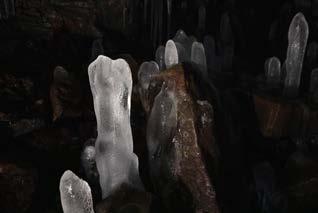
Lights out and home we go
We lingered a while in the massive chamber before calling time on the tour. We had advanced so deep into the lava tunnel that we couldn't see the light of day and we had to rely on artificial lights brightening up the cave. Before venturing toward the light, Jóna asked if we were up for an experiment and prompted us to put our phones and cameras away and turn off our headlamps. She also turned out her powerful flashlight. It was pitch dark in the cave. Nobody dared move or even make a sound. The only thing we could hear were the water droplets, drip, drip, dripping from the ceiling. The experience was so unique. I returned to the surface calm and relaxed, ready to go home and relive the beautiful memories of my day underground.

29 The Reykjavík Grapevine 3/23 Best before: April 13, 2023 TRAVEL Listen to Roses & Wine By Hippnotikka on Spotify Boa Constrictor (LP) out in April 2023
Smell, swirl, sip and skál!
The Reykjavík wine scene has never been livelier
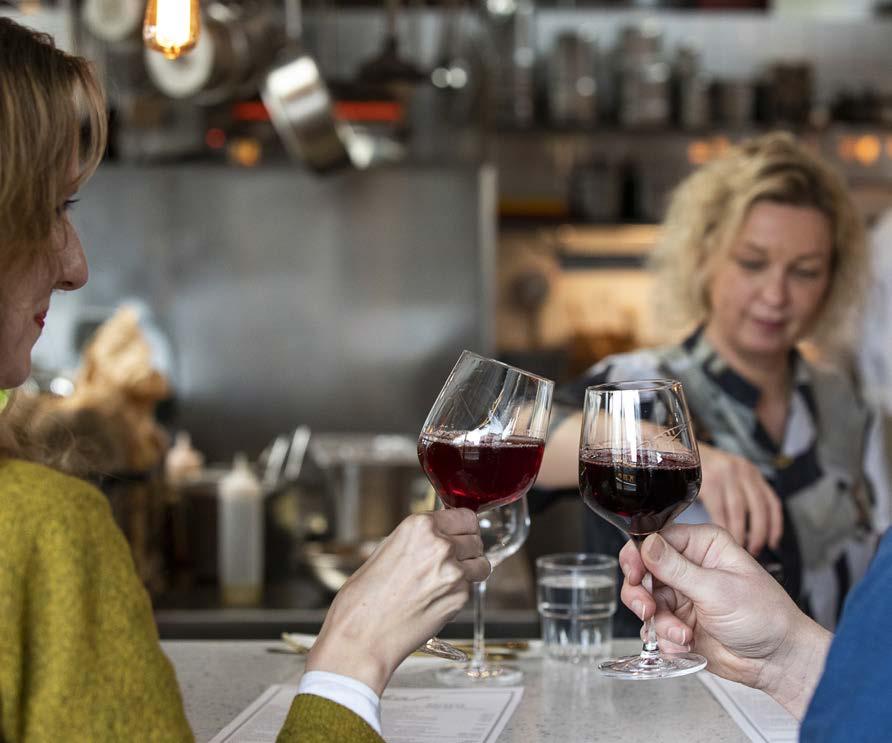 Words: Shruthi Basappa
Images: Art Bicnick
Words: Shruthi Basappa
Images: Art Bicnick
For much of the 20th century it was unpatriotic and illegal to drink beer. When full prohibition became law over a century ago, it was primarily for political reasons, but alcohol consumption in general was also frowned upon. History notwithstanding, today we boast a renewed appreciation for wine, a spurt in microbreweries and production of local spirits. Can we start bragging about having the most wine bars per capita? Perhaps so.

The world’s most expensive country for alcohol has seen a quiet transformation and, despite the challenges of taxation, the wine revolution is firmly afoot on this windy little island. It looks like Reykjavik is poised to be a bustling hub for oenophiles.

How far we’ve come
When asked about wine drinking over time, Ólafur Örn Steinunnar Ólafsson admits he is old enough to remember far back, “all the way to the 80s even, and that is well before any sort of wine culture in this country,” he chuckles. “Back then, people were drinking vodkaCoke with their meals,” he recalls, “and wine was mostly a means to get a buzz on, much like the vodkaCoke.”
Ólafur is a serial restaurateur and one of the owners behind restaurant Brút and wine bar Vínstúkan. He says that with the growing number of restaurants and the introduction of affordable new world wines the perception of both wine and drinking itself has slowly changed. “Now we hardly ever get the vodka-Cokers, " he laughs. That change has been particularly accelerated in the past 20 years. “New world wines are hundreds of years old, old world wines are thousands of years old. 20 years in the scope of wine,” Alba Hough clarifies sagely, “is a blip on the radar.” Alba is a lauded sommelier, the Star Wine List ambassador for Iceland and oversees production at Himbrimi Gin.
Both Alba and Ólafur agree that travel has been a great driver for advancement in how palates and preferences have grown. Beyond

a thing of the past, though it may exist in some pockets, Alba admits.
“In the 80s and 90s there was a preference for Spanish wines, Bordeaux in particular with French wines, Italian yes, a little bit of new world from Australia started to show,” she says, adding that “anything else was seen like a fringe to the idea of wine, anything else was a bit of a gamble.” She notes that the New Nordic manifesto in the early 2000’s marked a shift in consumption with a focus towards sustainability and conversations around what’s local became more prevalent.
“The Icelander is not afraid to try new things, but we are also not afraid to tell you if it is shit,” Alba is candid, “This pragmatism — of knowing what we like and what we don’t like, is of equal importance,” she stresses. It’s helped the wine scene grow substantially in her view and the evolution has been fairly fast.
On the other hand, the country’s fraught history with alcohol does seem to influence inclinations still. When Spain threatened to stop importing salted cod if Iceland
the Icelandic penchant for “chasing Vitamin D" in sunny Benidorm and Tenerife, the two note that the trend more recently has been the “frequency of travel destinations beyond Spain, formal education, an exposure to different cultures and globalisation.”
Shifting preferences

While tasting menus are commonplace now, Alba laughs as she remembers her first time in early 2007 introducing a shocked diner to the preposterous concept of serving five to six different wines for each course! What has also changed is the mentality of choosing wine bottles by alcohol percentage — a habit that developed in response to the state’s taxation system. It is
didn’t buy Spanish wine in return, it prompted politicians to bow to pressure and legalise importing reds and rosés from Portugal and Spain in 1921.
César Garduño, head sommelier at Credo, Norway and in the recent past at Dill and Pujol, observes a similarity between Icelandic and Mexican diners, “Back in the day,
most wine drunk in Mexico and Iceland was Spanish; in Mexico because of colonisation, in Iceland because of the fish. So in terms of wine palate, they like a medium to full body profile,” he explains.

No longer the fringe
I’ve often said that food trends come to die in Iceland. When the world fell in love with cupcakes and gastropubs, we did too — albeit 15 years too late. When it came to natural wines however, we were right there along with the rest of the trendsetters. In a market otherwise controlled by state-owned Vínbuðin, chefs and restaurants led the charge, steering a fairly conservative market that still had choices made for them by showcas-
FOOD FEATURE
Food 30 The Reykjavík Grapevine 3/23 Best before: April 13, 2023 SÆTA SVÍNIÐ / Hafnarstræti 1-3 / Tel. 555 2900 / saetasvinid.is 990 1.690 HAPPIEST HAPPY HOUR IN REYKJAVÍK
“Back then, people were drinking vodka-Coke with their meals and wine was mostly a means to get a buzz on.”
ICE LANDIC GASTROP UB
ing natural wines front and centre on their menus.
Chef Gunnar Karl Gíslason of green Michelin starred Dill was one of the first to embrace the funky, sometimes divisive brew at his restaurant. “Many natural wines are quite unusual in their expression and behaviour, making them all the more interesting and delicious to better complement our menu,” he shares. “In addition, they tend to be quite multi-faceted, making them even more fascinating to pair with our food in order to further enhance our guests’ experience.”
As Gunnar puts it, people have been making fermented grape juice without additives for thousands of years (although there are accounts of sulfites being used to preserve wine as far back as the 8th century BC). “People think it is a fad or a trend,” he says, “but it’s the traditional way to make wine.”
Wine bars and more
There has been a noticeable increase in the number of wine bars in Reykjavík. Where one long had to suffer a ‘house wine’ in a bar, today’s wine bars centre wines from worlds old, new and in-between. Most of them, unsurprisingly, are concentrated in the heart of downtown Reykjavík, but menus across the country are starting to see a smattering of natural wines, jostling for space with conventional wines.
Still, this sea change is being driven by individuals and establishments who very often are satisfying a craving for choice that has until now been lacking. Ben Boorman and Halldór Halldórsson aka Dori DNA are behind Mikki Refur, an all day wine bar that is a cafe at 11 a.m. and a slick wine bar come 11 p.m.
“We did want to monetise the building we were renting,” Ben is honest, “so a daytime offering seemed a logical way to go about that. So a mix of concept and pragmatism,” he offers, going on to add that Mikki
Iceland, Manuel Schembri, head sommelier and head waiter at Brút restaurant was a semi-finalist at the ASI Best Sommelier of the World 2023 competition. Held once every three years by the Association de la Sommellerie Internationale, the gruelling competition is spread over multiple days and battletests the best sommeliers of each participating country to exacting standards. Manuel was also recognised as the 14th best sommelier in the world.

Mexican festa with Icelandic seafood and lamb
is the way it is because, “the worlds of coffee and wine are inextricably linked as pleasures of the senses, with the added bonus that both make you feel some kind of way.”
Ólafur expresses this same desire for a space that was nice, informal, and no nonsense in which to drink. Which is what he did with heading-towards-institution Vínstukan that he runs with Bragi Skaftasson and chef Ragnar Eiriksson. As he bluntly puts it, “we sell what we like, and we don’t drink crap. We focus on interesting wines, mostly natural, but don’t discriminate against more conventional wines, as long as they are not from corporate wineries and only European. Quality for price is what we focus on.”

It is interesting to note that almost every wine bar has its own independent import company. Ben and Dori are behind Berjamór, the couple behind Apéro Vínbar, Marie-Odile Désy and Garðar Víðir Gunnarsson import their own stock, and Gísli Grimsson and Björn Steinar are behind importer Rætur og Vín.
As Gísli, owner of Saltverk and Skál puts it, “it didn't make
Last year at the Star Wine List Awards, Dill took home silver for both Sustainable Wine List of the Year and the Best Short List of the year, while Brút bagged silver in three categories - Sparkling Wine List (appropriate, of course), Austrian Wine List and the Mediumsized Wine List. Add to this mix Michelin Star recognitions for Dill and Ox, and a 50 Best Discovery spotlight on cocktail bar Jungle, and you’ll soon recognise the country’s potential as a global dining destination.
What's next?
We will continue to see more wine bars and more restaurants offering interesting wine lists, all those I spoke with agreed. Even if “they are popping up everywhere like daisies!” exclaims Alba enthusiastically. “Wine should be fun and delicious,” Gunnar says and Gísli agrees, “natural wines today are always getting better with every year and Iceland is catching on that wines don't have to be super serious to be super fun to drink.”
It has to be said that this little revolution is also being led by sommeliers young and experienced who tell a story and lead you by hand, appealing to a whole new generation of wine drinkers otherwise excluded by the stiff formality. Drinking wine shouldn’t be like going to church where the sommelier, in place of a priest, stands between you and a good time. This rejection of jargon and bow ties in
We’re
sense for a small restaurant to be buying wines in whole pallets so we decided to start Rætur og Vín as an import company. Mostly because of the view that we believed that natural wines were amazing and they opened up a whole new world for us. The ideology of nothing added in the process resonated with the universe that we were already deeply involved in.”
International recognition
Earlier this year and in a first for
favour of enjoyment and preference unique to each diner plays a pivotal role in this changing landscape.

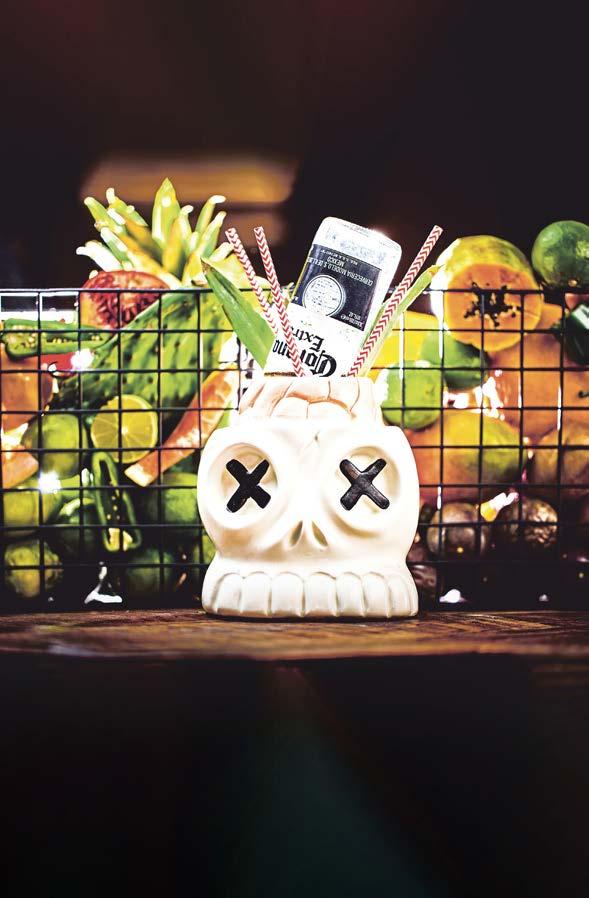
Whether we will see homegrown potato wine, a la Peru’s Manuel Choqque Bravo’s famed tuber wine served at Central, Kjoll and Mil remains to be seen. But for now, as Ben sums it up, “we are at one of those points where, in the future, we could look back and say, 'that was when the scene really changed in Iceland!'”

31 The Reykjavík Grapevine 3/23 Best before: April 13, 2023 Food
“The Icelander is not afraid to try new things, but we are also not afraid to tell you if it is shit.”
Book your table: Tel. +354 454 0333 treslocos.is We love Margaritas and tropical cocktails and offer a crazy selection of Tequila and Mezcal - over 50 types. Enjoy an explosion of favors at Tres Locos Our address: Hafnarstræti 4 101 Reykjavík @treslocos.rvk
loco about tacos, tostadas,
fajitas, quesadillas and other Mexican delicacies, made with fresh Icelandic ingredients.
Gauging the Icelandicness of Íslenski Barinn
Where Greenland is Ice and Iceland is Greenbacks
Words: Ragnar Egilsson Image: Art Bicnick

We all have our go-to places. Neighbourhood spots where you know the menu by heart, where you salute the waiters by name and chest bump the chef. I’ll hazard a guess that Íslenski barinn is not that place for many Icelanders. But who needs Icelanders when you have top ranking on the Chinese messaging app WeChat? Is that the kind of power that drives a person mad enough to start making flapjack puffin tacos? Let’s find out!

Sir, I’ll trade my Igloo for a slice of your fin whale
Laugavegur is seeing a mindboggling amount of tourists for midday, midweek, midwinter, midrecession. Not even the stormiest and coldest couple of months in recent memory have deterred these travellers. They want that goddamn lobster roll and if that means freezing to death in line outside Íslenski barinn, then so be it.
When we step inside I think this must be what it’s like for Italians to go to an Olive Garden. You are
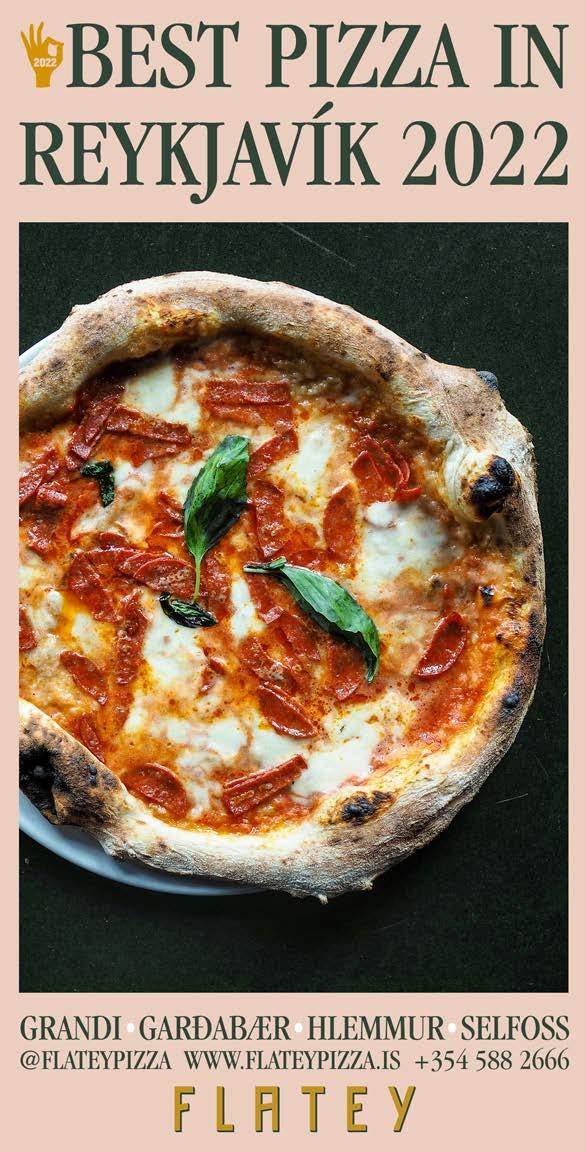







immediately hit with a familiar, musty grandma smell, which is, dare I say, a good sign. At the very least, it’s the right smell for a place serving plokkfiskur.

As for decor, Íslenski barinn is dodging some well-worn clichés and trading in some lesser known national characteristics. There are some signs that they aren’t shy about courting controversy, such as playing thoroughlycancelled troubadour Megas on the loudspeakers, tacking up a vintage placard protesting NATO and serving a shocking amount of controversial proteins on the menu — if you have a problem with fin whale hunting (as I do) then you will likely not be pleased that it features in more than one dish.
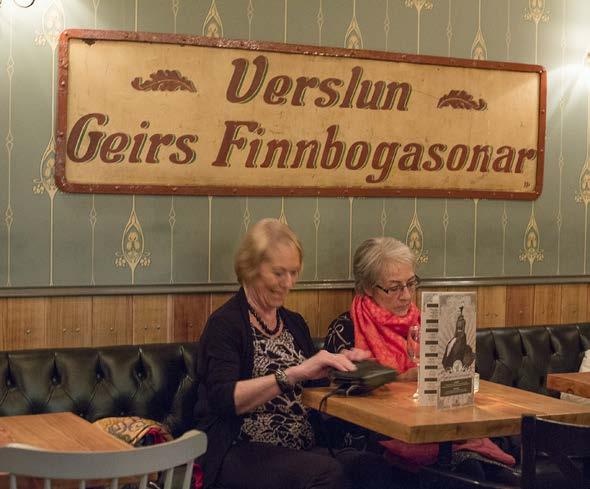
Is a hot dog without a hot dog still a hot dog?
Back to the aforementioned plokkfiskur. It’s a traditional Icelandic stew of shredded cooked haddock, chopped potatoes, onions, black pepper and bechamel. That’s it. Now, the version at Íslenski barinn
has seen the addition of both béarnaise sauce and cheese, upping the richness considerably. It’s very Icelandic to add béarnaise to everything, but the resulting dish failed to deliver. The potatoes were fully mashed, it was heartburninducingly rich and there wasn’t enough cracked pepper.

Our other main was the reindeer burger, which in Reykjavík are only distinguishable from beef burgers by their price. Still, this one was good.
It’s really the small bites that are worth a try at Íslenski barinn, and it’s those that have taken the tourist world by storm. The puffin skonsa is grilled puffin breast on a type of pancake, served with blueberries, remoulade and slices of fresh chilli. It’s probably the most gimmicky thing on the menu, but I admit it was a pretty tasty dish. The main problems here were the structural integrity of the flapjack and the fact that all of it was served lukewarm.
Finally, there’s the humarpylsa, the lobster hot dog, which is essentially a lobster roll, except the lobster has been fried in batter and is served with cheese, mayo and jam. Again, it was tastier than expected, but the lobster gets lost in the pillowy bun, crusty batter and mountain of fatty condiments. Which is, again, quite an Icelandic thing to do.
According to China, it’s just this place and that one volcano
So what’s the verdict? The place is more authentically Icelandic than expected, though it’s hard to tell what is a conscious display of national pride and what just comes gushing out of the owners’ DNA. The service was attentive and responsive, making for a welcoming atmosphere, and the food is as advertised. If you go in for this kind of stuff, then you’ll be in safe hands but I’d be lying if I said I’ll be frequenting the place.
Then again, they don’t need me for this concept to work. Not only do they seem to be making money hand over fist in a challenging economy, but their cultural influence outside of Iceland is significant enough that the place is veering on genuine cultural relevance. Because we are fooling ourselves if we think that the Icelandic identity we wish to project will be carefully handled by national tourist bureaus. Like it or not, it will be carved by the storm of whispers on the socials, funnelling attention to pubs serving fin whale flapjacks.
32 The Reykjavík Grapevine 3/23 Best before: April 13, 2023 REVIEW
Food PHONE : 5522-444, 692-0564 banthai130@gmail.com
BEST
2021, 2020, 2019, 2018, 2017, 2016, 2015, 2014, 2013, 2012, 2011, 2010 AND 2009, BEST GODDAMM RESTAURANT 2011 TOP TEN : BEST RESTAURANTS IN ICELAND DV. 17.06.11 Laugavegur 130, Hlemmur, 105 Reykjavík Lots of options for vegetarians. Ban T hai w w w . b a n t h a i . i s R E S T A U R A N T Laugavegi 28 537 99 00 sumac@sumac.is sumac.is
Ban Thai is not “fast food” restaurant food made fresh from scratch, it‘s not pre-made, every meal take some time to cook.
THAI FOOD 2022
If your bar has a happy hour, email us on events@grapevine.is with the details


A
Every Happy Hour
00 to 18 : 00 Beer 1000 ISK, Wine 1000 ISK.
Tue-Sat
Beer 890 ISK, Wine 890 ISK
Every day from 16 : 00 to 18 : 00
Beer 850 ISK, Wine 850 ISK.
Every day from 16 : 00 to 19 : 00
Beer 750 ISK, Wine 900 ISK.
Every day from 16 : 00 to 19 : 00
Beer 800 ISK, Wine 900 ISK.
Every day from 15 : 00 to 18 : 00
Beer 990 ISK, Wine 1090 ISK.
Every day from 12 : 00 to 19 : 00
Beer 900 ISK, Wine 900 ISK.
Happy hour includes four selected tap
beers
Every day from 15 : 00 to 18 : 00
Beer 1000 ISK, Wine 1000 ISK.
Every day from 17 : 00 to 19 : 00
Beer 850
Stúdentakjallarinn
Every day from 16 : 00 to 20 : 00
700 ISK, Wine 1000 ISK.
Every day from 15 : 00 to 18 : 00 then 23 : 00 to 01 : 00
Cheap Eats
Here are some meal deals that’ll fill you up without emptying your wallet.
Sæmundargata 4 Spring break! Woo! Well, the universities’ spring breaks are behind us at this point and it’s not really “spring,” but the student bar at the heart of the University of Iceland campus is our pick for some March madness. With great offers on drinks and tasty food on the menu, you don’t need to be a student to enjoy the atmosphere. The spacious locale and energetic vibe makes it a great place to end a long day or kick off a wild night. Plus there’s often live music, pub quizzes, speed dating and other fun events. RX Happy
Happy hour / 4–7pm Beer / Wine / Cocktails
selection
from
Reykjavík
in 101
Every day from 16 : 00 to 19 : 00 Beer 600 ISK, Wine 750 ISK. Every day from 17 : 00 to 19 : 00 Beer 850 ISK, Wine 850 ISK. Wed-Sun from 14 : 00 to 17 : 00 Beer 990 ISK, Wine 990 ISK. Every day from 16 : 00 to 19 : 00 Beer 700 ISK, Wine 600 ISK. 2 F 1 on wine and beer on tap Tue-Sat from 15 : 00 to 18 : 00 Beer 1000 ISK, Wine 1000 ISK. Discount or a free appetiser. Every day from 14 : 00 to 19 : 00 Beer 600 ISK, Wine 850 ISK. Every day from 15 : 00 to 18 : 00 Beer 990 ISK, Wine 1190 ISK. Every day from 16 : 00 to 18 : 00 Beer 800 ISK, Wine 900 ISK. Every day from 16 : 00 to 21 : 00 Beer 800 ISK, Wine 1000 ISK. Every day from 16 : 00 to 19 : 00 Beer 850 ISK, Wine 850 ISK. Mon, Tues, Wed 16 : 00 - 18 : 00 , Thursday from 16 : 00 - 20 : 00 , Weekends from 12 : 00 to 18 : 00 Beer 750 ISK, Wine 900 ISK. Every day from 16 : 00 to 18
00 Beer 900 ISK, Wine 1000
Cocktails 1600 ISK. Every day from 16 : 00 to 19 : 00 & 22 : 00 to 23 : 00 on TueSat Beer 890 ISK, Wine 1050 ISK. Every day from 12 : 00 to 19 : 00 Beer 600 ISK, Wine 1000 ISK.
day from 16 : 00 to 19 : 00 Beer 950 ISK, Wine 950 ISK.
day from 16 : 00 to 20 : 00 Beer
Wine
ISK. Every day from 15 :
:
ISK
Every
Every
860 ISK,
950
from 15 : 00 to 18 : 00 Beer 1000 ISK, Wine 1000 ISK. Discount or a free appetiser.
Beer
Every day from 16 : 00 to 19 : 00
850 ISK Wine 1100 ISK.
Beer
ISK. AKJALLA R INN Everyday from 16 : 00 to 19 : 00 Beer 610 ISK Wine 850 ISK. Every day from 12 : 00 to 19 : 35 Beer 800 ISK, Wine 800 ISK. Every day from 15 : 00 to 20 : 00 Beer 750 ISK, Wine 800 ISK. FEATURED DRINKING HOLE
00 Saturday & Sunday 16:00 - 21:00 Additional discounts at all times with valid Student ID Card from
university
33 The Reykjavík Grapevine 3/23 Best before: April 13, 2023 Food
Hours Monday-Friday 16:00 -19
any
in the world.
Hverfisgata12
RÖNTGEN
Shopping & design
tion process is similar to winemaking, where humidity, time and temperature affect the final product. “We tried the same cacao bean that we're using now in five different styles of fermentation, and it was crazy to see how they all vary.”
The beans take about a week to ferment, another week to dry, and then they are transferred to warehouses for about three months to reduce their moisture content before shipping.
The heart of the bean
Once the groundwork has been laid and the beans arrive in Iceland, the Omnom team takes over. “When it comes into house, the biggest impact we can have with the flavour is the roasting part,” says Kjartan.
There are different methods of roasting cacao beans, depending on the desired end flavour. “We usually go for something that we call a mid-low roast. It's a very light roast.”
Omnom roasts their cacao beans in-house before cooling them down overnight. The next step is winnowing the beans, which means removing their outer shell. “The machine breaks the entire bean down and separates the husk. Inside you'll find the nibs — the heart of the cacao bean,” Kjartan continues.
“From there on, we take our nibs and start grinding them into a paste,” he says. “The nibs are almost 50% fat, and the fat is really what makes chocolate have that delicious mouthfeel.”
We Scored the Golden Ticket
Words:
Iceland is known for many things, but chocolate wasn’t one of them — until recently. These days, in almost every grocery shop in town you’ll see rows of colourful chocolate bars, unlike any you’ve ever come across before. They’re from Omnom, where we find ourselves together with the Co-Founder and the Head Chocolate Maker Kjartan Gíslason to learn how the magic is made.
Kjartan and entrepreneur Óskar
record they first broke last year. All of Omnom’s chocolate is hand-packaged and shipped worldwide.
Whether you’re a chocolate lover or you hate the stuff, you most definitely know the taste. But what’s the secret behind a morsel of chocolate that melts in your mouth? It took us two visits to the Omnom factory to find out.
It starts with a bean
us a dried cacao fruit, saying: “It takes the tree five years from being a little seedling to developing the fruits. For the fruits, it takes eight months to grow on the stump of the tree.”
Omnom uses only organic certified beans from farms in Madagascar, Nicaragua and Tanzania. “I would say 98% of all cacao in the world is technically organic. It's pretty hard, almost impossible to fast-produce cacao,” Kjartan explains, adding that cacao trees are rather demanding — they don’t like direct sunlight and often require farmers to plant other trees around them for shade.
From bitter to better
The longer you grind the nibs, the more flavours will develop, and the finer and silkier the cacao mass will become. “The next step would be deciding what you're going to do with your cacao mass: milk chocolate or dark chocolate?,” Kjartan says. “If you're making a regular 70% dark chocolate, you would just add sugar to it. With milk chocolate, you add dried milk because you can't add any liquid
órðarson started Omnom in 2013 out of their curiosity about the chocolatemaking process. Almost a decade later, Omnom has about 30 employees and buys from 15 to 18 tonnes of cacao beans yearly, with a capacity to produce one million chocolate bars — a


Þ

The very first step to making chocolate is cultivating and harvesting cacao beans. “You need very specific climate for the cacao pod to thrive,” Kjartan shares. “Cacao grows in areas that are just around the Equator.” He shows
“The cacao pod has little seeds inside it — what we call the beans. This is what chocolate is made from,” Kjartan says. The white pulp found in the fresh cacao fruits is very high in fructose, it helps to develop the flavour of the cacao during the fermentation process.
Fermentation is one of the most crucial steps in chocolate-making. “If you don't ferment your cacao beans, you wouldn't get that nice chocolate flavour that we like,” says Kjartan.
He explains that the bean fermenta-

EXPLORE UNSEEN ICELAND



34 The Reykjavík Grapevine 3/23 Best before: April 13, 2023
ON THE ULTIMATE FLYING RIDE OPEN EVERY DAY | flyovericeland.com
IT’S MADE
HOW
Iryna Zubenko
Learning how Omnom chocolate is made Gitte Van der Meersch & Art Bicnick
Images:
to the cacao mass. It's so fatty it won't mix.”

Next in line
Before the chocolate is ready to be packaged, it is tempered. “Tempering is about cooling down the chocolate to a certain degree and then reheating it back to another degree,” Kjartan says, adding: “Untempered chocolate is definitely edible, it just doesn't have that nice shiny appearance.”
“For instance, you would cool down 70% chocolate to around 26° Celsius and then reheat it up to 32° Celsius,” he explains. “When you dispense it at that degree, you cool it down really fast, and get that nice shine and snappiness to the bar. It just melts perfectly. This is when the chocolate is ready to be packed.”
Playing with flavours
with extraction of the liquorice root. It has pure liquorice flavour to it.”


Chocolate entertainment
“When we started talking about Omnom with my partner Óskar, we knew we wanted to make good chocolate. But we also knew we wanted to be a little different,” shares Kjartan. “Chocolate, for me, is about having fun, first and foremost.”
The element of fun runs through Omnom’s core, from the company’s name (which Kjartan jokingly refers to as “silly”) to its playful packaging featuring unicorns, pandas and sheep. “Most of the chocolate bars that we're testing out, had very

conservative packaging that didn't feel fun,” Kjartan admits.



“Our first chocolate bars were made with moulds that we bought online, just these classic tablets. We wanted to be so much more fun than the rest of the competition,” he says. “We immediately started designing our own kind of pattern,” Kjartan opens a chocolate bar, and snaps a little piece. “There's a little secret there. You need to find it yourself.”
Grab some delicious Omnom chocolate bars at Grapevine Store and keep an eye on our YouTube channel to join us on our trip to the chocolate factory.
“My background is as a chef, so my approach to making chocolate is first of all experimentation,” Kjartan shares. With flavours ranging from burnt barley to liquorice and raspberry, Omnom’s approach to flavour is anything but conventional. “We've done many crazy experiments here since we started, we even tried using soy sauce once.”
“I think the white chocolate category is where I have the most fun. With dark chocolate, I feel like I'm perfecting my skills,” Kjartan confesses. “Chocolate is 50% fat, and what you use for white chocolate is just the fat — you extract it from the cacao mass. You can use it as a blank canvas for any kind of other flavouring. It's like an alternative multiverse of chocolate,” he says. “One of our popular bars is a liquorice chocolate bar, which is technically a white chocolate made
35 The Reykjavík Grapevine 3/23 Best before: April 13, 2023
Jói’s Scandinavian
Words: Jóhannes Bjarkason




Images: The Internet
The days are getting longer. The air is getting warmer. The sun is for sale. That’s right. At Efnisveitan, you’re able to purchase second hand commercial items. Like the sun that adorned the ceiling of beloved shopping mall Kringlan for a good 20 years. Hit us up if you know a good place for it.
1. Bastua Water Jug available at IKEA, Kauptún 4 - 2.990 ISK

2. City Libraries Annual Pass available at any city library - 2.800 ISK

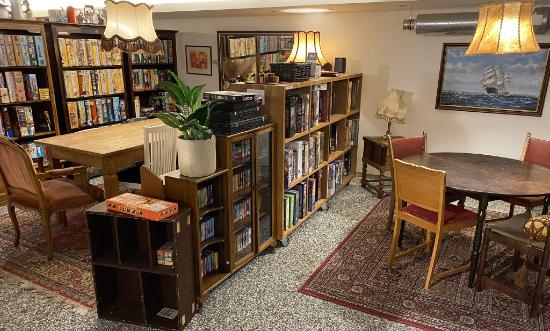


3. I Must Be the Devil LP – Kristín Anna Valtýsdóttir available at Lucky Records, Rauð arástígur 10 –5.999 ISK

4. Lúpína, poster available at Hrím, Kringlan - 8.990 ISK
5. Birkenstock Arizona available at Steinar Waage, Kringlan – 14.995 ISK

6. Sveitapeysa, salvia available at Kormakur og Skjöldur, Laugavegur 59–22.900 ISK
7. The Sun from Kringlan Stjörnutorg available online from Efnisveitan - 120.000 ISK
8. Royal Pipp bú ð ingur available at Krónan – 270 ISK
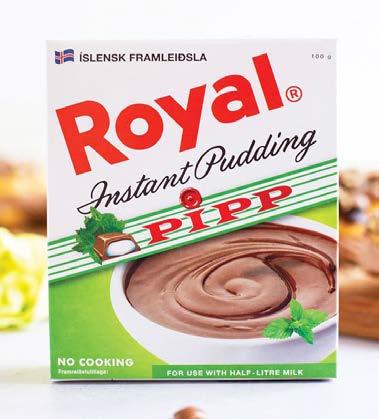

36 The Reykjavík Grapevine 3/23 Best before: April 13, 2023
❺ ❻
THE HAUL



37 The Reykjavík Grapevine 3/23 Best before: April 13, 2023
60th Anniversary Exhibition from the museum collection. Austurmörk 21 | 810 Hveragerði | Sími 483 1727 | www.listasafnarnesinga.is Shopping & Design ❼ ❹
Scandinavian Mood Board
Shhhhhhhhhhh!
Meet your friendly neighbourhood librarian
Words: Jóhannes Bjarkason Image: Gitte Van der Meersch
Hólmfríður Gunnlaugsdóttir, Librarian and specialist at Borgabókasafnið Grófinni.

How long have you worked here and how do you like it?
I’ve worked at the City Libraries for 23 years. I worked for 10 years at Gerðuberg, and since then I have been here. It’s a very diverse job.

For example, now I’m working on the first floor where I assist people with general service. Then I’m sometimes on the second floor, where the kids’ section is, which is a bit different. On the fifth floor are the academic books where we assist people with academic sources and the like.
I also manage a project called Artótek in collaboration with SÍM (Association of Icelandic Visual Artists), where people can rent artworks for extended periods of time. If they end up paying the full price of the artwork, then they can own it. Right now we have around 200 pieces that are being rented, with approximately 10 pieces rented each month.
The job is fun because it is so diverse and we take great care of the books. Arranging, displaying, and cleaning the books. Then we also fine tune the books on the shelves, as they can get mixed up. No day is the same.

What other profession would you like to try, if there were no limits?
Maybe gardening. Working with your hands outside. Digging like a mole.
Physical or audio books?
I use both. I haven’t gotten the hang of electronic books, whether it’s reading on the phone or on a tablet. I prefer to listen to or read books. Turn the pages.
Is there such a thing as too many books?
No, I don’t think you could say that. Although, sometimes you have to throw one out if you decide to get a new one.
What would come as a surprise to most people about how things work here?
The libraries are changing a lot. We have a podcast studio and people come in here to record. To access it, you only need a library card. We also have workshops, where you can access various computer programs, like music programs. In one library, we have a sewing machine where people can mend their clothes. People are surprised when they find out we have more than books.
Does it always need to be quiet in the library?
No, we try to keep specific areas where people can study or be in silence. You can’t make a ruckus. You can’t run around and scream, but you can talk.
What’s the weirdest thing you’ve encountered while working here?
Sometimes when I’m arranging books you see all sorts of things used as bookmarks. One time I found a menstrual pad in a book. These days, you find less of these sorts of things.
38 The Reykjavík Grapevine 3/23 Best before: April 13, 2023 Exit
THE VILLAGE PEOPLE
WELL, YOU ASKED
Get Your Avocados in Tenerife, B-day Boy

And other sage advice from the Grapevine
Words: Catherine Magnúsdóttir
Why are avocados so expensive?
It’s the price for coolness and chiqué, my friend. The ultimate freshness on toast requires a tribute and that tribute is attached to a lot of water.
Seriously, A LOT of water. Jeez. I mean, the environmental factor alone. (*shiver*).

Oh. And inflation. Shit be pricey these days.
Image: Midjourney, using "Tenerife Birthday Avocado" as the prompt



What’s with Tenerife?
Ah yes, the Icelandic home away from home. A small volcanic island that draws in a lot of tourists. What can I say, Icelanders like their comfort zone but once in a while you gotta show something else on your insta stories. Something nice and fancy but maybe not too fancy and unfamiliar. Everybody gets to be the tourist sometimes, okay?
What's the best place to celebrate a birthday?
Easy. Abandoned Asylum. Privacy. Lots of free shit. Space. The remnants of mistreated souls joining in to party hard. Real hard. You can get totally bonkers with the decorations, too. You can also play all kinds of party games like Blindman’s Buff on hard mode or pin the stray jacket on the birthday looney. Have fun and go crazy coming to terms with the unraveling of time.
39 The Reykjavík Grapevine 3/23 Best before: April 13, 2023
LAST LOOK
Exit
Image: Art Bicnick
«————————————»




One of 25 wonders of the world Blue Lagoon geothermal seawater is unlike any other water on the planet. Born deep underground, this natural marvel is rich in silica, algae, and minerals—the elements that give the water its extraordinary powers. Discover the water. Experience the wonder. Airport Transfers All flights 45 min Free WiFi For our flexible Flybus schedule, please visit www.flybus.is, Prices from 3.499 ISK Prices & availability are subject to change without notice. mountainguides.is BOOK NOW Adventure Day Tours POTENT QUOTABLES “We’re getting new swear words with the English influence, like ‘sjitt’.” Learn to curse in Icelandic on Page 6 « » “A Vinland Colony of
size might not have been
lost to Europe.” Valur Gunnarsson asks “what if Vikings colonised North America?” on Page 8 « » “Iceland has always had its own community of nerds. High Fa ntasy
nothing new
Catherine Magnúsdóttir rolls the dice with Reykjavík’s TRPG scene on Page 10 «————————————»
Jóhannes Bjarkason
the existence of Skeifan on Page
any
completely
is
in the land of the Edda.”
“Due
to the fact that most streets are parking lots, neither human nor natural laws apply.”
ponders
14 «————————————»
Ensemble
artists on
“It’s impossible for anybody — for any human being I know — to do things entirely by themselves.”
Reykjavík
elevates marginalised
Page 16
on working with big names, turning down big projects on Page 24 ISSUE 3, VOL 20 BEST BEFORE: APRIL 13, 2023 PRICE: 0 KR.
“My work resonated with M. Night and the process started nicely. He gave me free rein .” Herdís Stefánsdóttir,
 The die will be cast... on page 12
The die will be cast... on page 12






















































































































 Words: Shruthi Basappa
Images: Art Bicnick
Words: Shruthi Basappa
Images: Art Bicnick
































































